- LI 1 (Shāng Yáng, 商阳)
- LI 2 (Èr Jiān, 二间)
- LI 3 (Sān Jiān, 三间)
- LI 4 (Hé Gǔ, 合谷)
- LI 5 (Yáng Xī, 阳溪)
- LI 6 (Piān Lì, 偏历)
- LI 7 (Wēn Liū, 温溜)
- LI 8 (Xià Lián, 下廉)
- LI 9 (Shàng Lián, 上廉)
- LI 10 (Shǒu Sān Lǐ, 手三里)
- LI 11 (Qū Chí, 曲池)
- LI 12 (Zhǒu Liáo, 肘髎)
- LI 13 (Shǒu Wǔ Lǐ, 手五里)
- LI 14 (Bì Nào, 臂臑)
- LI 15 (Jiān Yú, 肩髃)
- LI 16 (Jù Gǔ, 巨骨)
- LI 17 (Tiān Dǐng, 天鼎)
- LI 18 (Fú Tū, 扶突)
- LI 19 (Kǒu Hé Liáo, 口禾髎)
- LI 20 (Yín⁝ Xiān⁝, 迎香)
The large intestine channel has 20 bilateral points: 15 on the radial side of the back of the upper limb, 3 on the neck and shoulder, and 2 on the face. The first is on the radial side of the index fnger, LI 1 (shān⁝ yán⁝); the last, in the nasolabial groove, LI 20 (yín⁝ xiān⁝). These points are responsible for diseases of the head and abdomen (eye, ear, mouth, teeth, nose, throat, stomach, and intestine) and the running course of the channel.
LI 1 (Shāng Yáng, 商阳)
Jing-well point
Location On the index fnger radial to the distal phalanx, 0.1 cun proximal-lateral to the radial corner of the index fngernail where a line along the radial border of the fngernail and a line at the base of the index fngernail intersect (Pic. 3-6).

Actions. Clear heat to release exterior, and open the orifices to resuscitate.
Indications. Pharyngitis, swollen jaw, dry mouth, toothache; febrile diseases, apoplexy, syncope; numbness of the index fnger.
Manipulation. Acupuncture: 1. Needle perpendicularly 0.1~0.2 cun to produce local soreness and distention. 2. Bleed with a three-edged or thick fliform needle. Moxibustion: Use 1~3 cones of wheat-grain sized moxibustion, or use a moxa stick for 5~10 minutes.
Precautions. See LU 11 (shào shāng).
Annotation. The point appeared in The Spiritual Pivot-Fundamental Points (Líng Shū-Bĕn Shū,灵枢-本输). The large intestine channel traverses the yang aspect of the body after separating from the lung channel, and the musical tone of the lung is shāng; thus the point was named shāng yáng.
Modern clinical observation and research. In a case series, LU 11 (shào shāng) and LI 1 (shān⁝ yáng) were bled with a three-edged needle once every 10 days to treat chronic tonsillitis; the bleeding was stopped when the blood turned from dark to bright red. Three treatments constituted a course. After 1~3 courses, 32 patients recovered (47.1%); 28 received some benefit (41.2%); 8 cases were unsuccessful (11.8%).1
LI 2 (Èr Jiān, 二间)
Ying-spring point
Location On the index finger in the depression distal to the radial side of the second metacarpophalangeal joint at the border between the red and white fesh (Pic. 3-6).
Actions. Release the exterior, clear heat, and soothe the throat.
1 Li LX. Bloodletting at LU 11 (shào shāng) and LI 1 (shān⁝ yáng) to treat chronic tonsillitis少商、商阳二穴放血治疗慢性扁桃腺炎68例. Journal of External Therapy of Traditional Chinese Medicine. 2001; 10(6): 21.
Indications. Febrile diseases of the five sensory organs such as pharyngitis, swollen jaw, nosebleed, eye pain, yellow eyes, toothache; dysfunction of infexion and extension and pain of the index fnger.
Manipulation. Acupuncture: Needle perpendicularly 0.2~0.4 cun to produce local soreness and distention. Moxibustion: Use 3~5 cones of wheat-grain sized cones, or use a moxa stick for 5~10 minutes.
Precautions. Scarring moxibustion is prohibited at metacarpophalangeal joints.
Annotation. The point appeared in The Spiritual Pivot-Fundamental Points (Líng Shū-Bĕn Shū,灵枢·本输). Jiān means space; since the point is located in the front depression distal to the second metacarpophalangeal joint, it is called èr jiān, second space.
LI 3 (Sān Jiān, 三间)
Shu-stream point
Location On the dorsum of the hand in the depression radial and proximal to the second metacarpophalangeal joint (Pic. 3-6).
Actions. Clear heat, relieve pain, and soothe the throat.
Indications. Toothache, swollen and sore throat; abdominal distention, borborygmus, diarrhea, dysentery with pus and blood; dorsal swelling and soreness of hand and fnger.
Manipulation. Acupuncture: Needle perpendicularly 0.3~0.5 cun to produce local numbness and distention that radiates to the dorsum of the hand. Moxibustion: Use 3~5 cones of cone moxibustion, or use warming needle moxibustion for 20 minutes, or use a moxa stick for 5~10 minutes.
Precautions. See LI 2 (èr jiān).
Annotation. The point appeared in The Spiritual Pivot-Fundamental Points (Líng Shū-Bĕn Shū,灵枢·本输). Jiān means interval or space. The point is the third of the points on the index fnger; hence sān jiān, third space.
LI 4 (Hé Gǔ, 合谷)
Yuan-source point
Location On the dorsum of the hand at the midpoint of the second metacarpal bone on the radial side (Pic. 3-6).
Location method. With the patient’s thumb and index fnger folded, the point lies in the muscle at the midpoint of the second metacarpal on the radial side (Pic. 3-7).
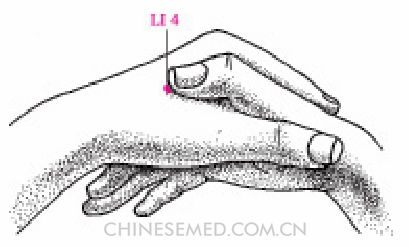
Actions. Dredge channels and activate collaterals, release the exterior and clear heat.
Indications. Externally contracted diseases such as febrile diseases without sweating, common cold with sweating, cough; diseases of head, face, and fve sensory organs such as headache, dizziness, nasal congestion, nosebleed, sinusitis, deafiness, tinnitus, swelling and pain in the eyes, blepharoptosis, toothache, swollen and sore throat, aphtha, trismus, deviated mouth and eye, glossodynia; diseases of stomach and intestines such as stomachache, constipation, dysentery; gynecological diseases such as menstrual irregularities, dysmenorrhea, amenorrhea, delayed labor, retention of placenta, persistent lochia, lactation difficulties; spasms of the fnger and dysfunction in fexion and extension, arm pain, paralysis of the forearm.
Manipulation. Acupuncture: 1. Needle perpendicularly 0.5~1.0 cun to produce local soreness and distention that radiates to elbow, shoulder, and face. 2. Needle deeply about 2.0 cun to produce palm soreness and numbness that radiates to the tip of fnger. Moxibustion: Use 5~9 cones of cone moxibustion, or use warming needle moxibustion for 20 minutes, or use a moxa stick for 10~20 minutes.
Precautions. Avoid piercing local veins and arteries by not angling the tip of the needle toward the side of wrist. Strong lifting and thrusting can damage the vessels and cause hematoma. This point is prohibited in women who habitually miscarry.
Annotation. The point appeared in The Spiritual Pivot-Fundamental Points (Líng Shū-Bĕn Shū,灵枢·本输). Hé means join or converge; gǔ means valley or gorge. The point lies in a depression like a valley between the first and second metacarpals, so it was named hé gǔ.
Modern clinical observation and research. In an RCT on postoperative dental pain, mean pain-free postoperative time was significantly longer (172.9 vs. 93.8 minutes; P=0.01) in the acupuncture group (n=19) than for placebo (n=20). Mean time before requesting pain medication was significantly longer in the treatment group (242.1 vs. 166.2 minutes; P=0.01). Average pain medication consumption was significantly less in the treatment group (1.1 vs. 1.65 tablets; P=0.05).1
LI 5 (Yáng Xī, 阳溪)
Jing-river point
Location On the anterolateral aspect of the wrist, distal to the radial styloid process in the depression of the anatomical snuffbox at the radial side of the dorsal wrist crease (Pic. 3-8).

Location method. With the thumb up, the point lies between the extensor pollicis longus and brevis tendons on the dorsum at the radial side of the wrist.
Actions. Clear heat and disperse wind, relax sinews and soothe the joints.
Indications. Headache, eye swelling and pain, deafiness, tinnitus, nosebleed, toothache, swollen and sore throat; febrile diseases, dysphoria, psychosis, epilepsy, mania; wrist pain, fnger spasms.
Manipulation. Acupuncture: 1. Needle perpendicularly 0.5~0.8 cun to produce local soreness and distention. 2. Treat stenosing tenovaginitis of the thumb with lateral needling. Moxibustion: Use 3~5 cones of cone moxibustion, or use warming needle moxibustion for 20 minutes, or use a moxa stick for 10~20 minutes.
Precautions. Scarring moxibustion is forbidden, for the point lies near the joint and tendons.
Annotation. The point appeared in The Spiritual Pivot-Fundamental Points (Líng Shū-BĕnShū, 灵枢·本输). The dorsum of hand belongs to yang, and the depression between tendons and bones looks like a mountain stream. The point is called yáng xī because it belongs to yang and lies in the depression between the radius and carpus and between the extensor pollicis longus and brevis tendons.
LI 6 (Piān Lì, 偏历)
Luo-connecting point
1 Lao L, Bergman S, Hamilton G, Langenberg P, Berman B. Evaluation of acupuncture for pain control after oral surgery: a placebo-controlled trial. Archives of Otolaryngology: Head and Neck Surgery. 1999; 125(5): 567-72.
Location At the anterolateral aspect of the forearm on the line connecting LI 5 (yáng xī) with LI 11 (qū chí), 3 cun superior to the dorsal wrist crease (Pic. 3-8).
Actions. Clear heat, release urine, dredge channels, and activate collaterals.
Indications. Deafiness, tinnitus, nosebleed; borborygmus, abdominal pain; edema, inhibited urination, wind disease without sweating; arm and wrist pain.
Manipulation. Acupuncture: 1. Needle perpendicularly 0.3~0.5 cun to produce local soreness and distention. 2. Needle obliquely 0.5~0.8 cun toward the elbow to produce local soreness and distention that radiates to forearm and elbow. Moxibustion: Use 3~5 cones of cone moxibustion, or use warming needle moxibustion for 20 minutes, or use a moxa stick for 5~10 minutes.
Annotation. The point appeared in The Spiritual Pivot-Channels (Líng Shū-Jīng Mài, 灵枢·经脉). Piān means leaning to one side; lì means pass through. The point is named piān lì because it is the luo-connecting point of the hand yangming; channel qi emerges and passes from the yangming channel to the taiyin channel here.
LI 7 (Wēn Liū, 温溜)
Xi-cleft point
Location At the anterolateral aspect of the forearm on the line connecting LI 5 (yáng xī) with LI 11 (qū chí), 5 cun superior to the dorsal wrist crease (Pic. 3-8).
Actions. Regulate the intestine and stomach and clear pathogenic heat.
Indications. Intestinal diseases such as acute borborygmus, abdominal pain; diseases of head, face, and fve sensory organs such as swelling and redness of the face, pain of mouth, tongue, pain of dental caries, swollen throat, pharyngitis, swollen tongue; depression, mania, epilepsy; aching of shoulders, back, arm and wrist. Pressing pain at the point can be diagnostic of perforated ulcer of the alimentary canal.
Manipulation. Acupuncture: Needle perpendicularly 0.5~1.0 cun to produce local soreness and distention that radiates to the hand.
Annotation. The point appeared in The Systematic Classic of Acupuncture and Moxibustion (ZhēnJiŭ Jiă Yĭ Jīng, 针灸甲乙经). Wēn means warm; liū means retention. This is the xi-cleft point of the hand yangming where qi and blood gather deeply; it was given its name because it is infused with warm yang qi, and the yangming channel is full of qi and blood.
LI 8 (Xià Lián, 下廉)
Location At the anterolateral aspect of the forearm on the line connecting LI 5 (yáng xī) with LI 11 (qū chí), 4 cun inferior to the cubital crease (Pic. 3-9).
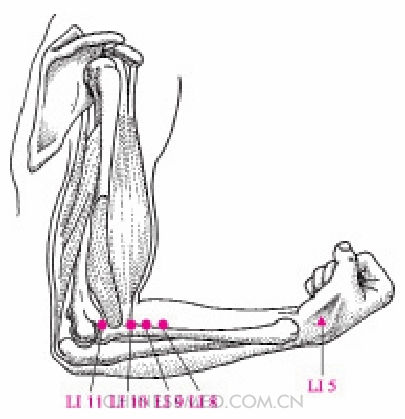
Actions. Regulate the intestine and stomach, clear pathogenic heat, and dredge channels and collaterals.
Indications. Intestinal diseases such as abdominal pain, abdominal distention, undigested food in stool, vomiting, diarrhea, dysentery; diseases of head, face, and the five sensory organs such as recurrent headache, vertigo, toothache, redness and pain in the eyes, blurred vision, dry lips, drooling; pain in elbow and arm.
Manipulation. Acupuncture: Needle perpendicularly 1.0~1.5 cun to produce local soreness and distention that radiates to the arm and fnger. Moxibustion: Use 3~5 cones of cone moxibustion, or use warming needle moxibustion for 20 minutes, or use a moxa stick for 5~10 minutes.
Annotation. The point appeared in The Systematic Classic of Acupuncture and Moxibustion (ZhēnJiŭ Jiă Yĭ Jīng, 针灸甲乙经). Lián means side. The point is called xià lián as it is 1 cun below LI 9 (shàng lián) on the lateral radial border of the forearm when the elbow is fexed.
LI 9 (Shàng Lián, 上廉)
Location At the anterolateral aspect of the forearm on the line connecting LI 5 (yáng xī) and LI 11 (qū chí), 3 cun inferior to the cubital crease (Pic. 3-9).
Actions. Regulate the intestine and dredge channels and collaterals.
Indications. Abdominal pain, abdominal distention, vomiting, diarrhea, borborygmus; headache, vertigo; asthma, urinary difficulty; diseases of the running course of the channel such as swelling, pain, and paralysis of arm and shoulder, paralysis of hand and elbow, numbness in the arm.
Manipulation. Acupuncture: Needle perpendicularly 1.0~1.5 cun to produce local soreness and distention that radiates to the hand. Moxibustion: Use 3~5 cones of cone moxibustion, or use warming needle moxibustion for 20 minutes, or use a moxa stick for 5~10 minutes.
Annotation. The point appeared in The Systematic Classic of Acupuncture and Moxibustion (ZhēnJiŭ Jiă Yĭ Jīng, 针灸甲乙经). Lián means side. The point is called shàng lián because it is above LI 8 (xià lián) on the radial border of the forearm when the elbow is fexed.
LI 10 (Shǒu Sān Lǐ, 手三里)
Location At the anterolateral aspect of the forearm on the line connecting LI 5 (yáng xī) and LI 11 (qū chí), 2 cun inferior to the cubital crease (Pic. 3-9).
Actions. Dredge fu-organs and channels, activate collaterals, clear heat, improve vision, and regulate qi.
Indications. Abdominal pain, diarrhea; toothache, loss of voice, swollen cheek, tongue pain, pain and redness of eye, blurred vision; diseases of the running course of the channel such as arm pain and paralysis.
Manipulation. Acupuncture: Needle perpendicularly 1~2 cun to produce local soreness, distention and heaviness that radiates to the dorsum of hand. Moxibustion: Use 5~7 cones of cone moxibustion, or use warming needle moxibustion for 20 minutes, or use a moxa stick for 10~20 minutes.
Annotation. The point appeared in The Systematic Classic of Acupuncture and Moxibustion (ZhēnJiŭ Jiă Yĭ Jīng, 针灸甲乙经). Lǐ is a measuring unit equal to 1 cun. With the elbow fexed, the point is 3 cun inferior to the lateral epicondyle of the humerus, so it is called shǒu sān lǐ.
Modern clinical observation and research. In case observations on the effects of acupuncture on the muscular tension of the brachioradialis of stroke patients and healthy people, LI 10 (shǒu sānlǐ) was needled and retained for 20 minutes. The physicians observed that acupuncture lowered the muscular tension of stroke patients and that this change in muscular tension endured for some time.1
LI 11 (Qū Chí, 曲池)
He-sea point
1 Ren ZW, Sun AJ, Cao KZ, Hu XY, Li GA. Effects of acupuncture at LI 10 (shǒu sān lǐ) on brachioradial muscle tension针刺手三里穴对肱桡肌肌张力的影响. Shanghai Journal of Acupuncture and Moxibustion. 2010; 29(12): 798-800.
Location On the lateral aspect of the elbow at the midpoint of the line connecting LU 5 (chĭ zé) with the lateral epicondyle of the humerus (Pic. 3-9).
Location method. With the patient’s elbow fexed at a right angle, the point is at the end of the transverse cubital crease.
Actions. Clear heat, dispel wind, harmonize ying-blood, reverse counterflow, and activate collaterals.
Indications. Externally contracted diseases such as swollen and sore throat, cough, asthma, febrile disease; abdominal pain, vomiting, diarrhea, dysentery, intestinal abscess, constipation; toothache, redness and pain in the eyes, blurred vision; dermatoses such as sores, scabies, urticaria, erysipelas; vexation, fullness in the heart, psychosis, susceptibility to fright, headache, neurasthenia; disorders of the running course of the channel such as swelling and pain in the arm, paralysis of the upper limb, disability of the hand, elbow and shoulder, pain of the shoulder, arm, and brachial nerve; hypertension, consumptive thirst, edema, menstrual irregularities, defcient lactation.
Manipulation. Acupuncture: 1. Needle perpendicularly 1.0~2.5 cun to produce local soreness and distention that radiates upward to the shoulder or downward to the fingers. 2. Needle deeply to penetrate HT 3 (shào hăi), producing local soreness and distention that radiates upward to the shoulder or downward to fingers. 3. To treat arm pain, use triple needling or bleed with a three-edged needle. 4. Needle slightly and obliquely toward the curved side of the elbow joint so that the sensation radiates to the fnger. Moxibustion: Use 5~7 cones of cone moxibustion, or use warming needle moxibustion for 20 minutes, or use a moxa stick for 5~20 minutes. To prevent hypertension, press LI 11 for 1~2 minutes every day so that a sensation of soreness and distention radiates downward.
Precautions. 1. If the needle tip encounters elastic resistance and pulsations during deep insertion, this is the brachial artery; withdraw the needle and angle it to avoid piercing the vessels. 2. Scarring moxibustion is forbidden at this point.
Annotation. The point appeared in The Spiritual Pivot-Fundamental Points (Líng Shū-Bĕn Shū,灵枢·本输). Qū means bending, chí means pond. Since it is the he-sea point of the hand yangming channel, qi pours into it like water flowing into a pond. With the elbow fexed, the transverse cubital crease looks like a shallow pond, so the point is called qū chí.
Modern clinical observation and research. In a case series, LI 11 (qū chí) was bled unilaterally to treat hordeolum (stye) by needling to 1~2 mm and extruding 2~3 drops of blood once a day. The two sides were rotated; four treatments constituted a course. Of 60 cases, all recovered, 51 after one course (85.0%), and 9 after two (15.0%).1
LI 12 (Zhǒu Liáo, 肘髎)
Location On the anterolateral aspect of the elbow superior to the lateral epicondyle of the humerus, anterior to the lateral supraepicondylar ridge (Pic. 3-10).
Location method. With the patient’s elbow fexed, the point is on the lateral side of the arm, 1 cun above LI 11 (qū chí) on the lateral border of the triceps brachii and the border of the humerus.
Actions. Dredge channels and activate collaterals.
Indications. Diseases of the local area such as shoulder, arm, and elbow pain; numbness, spasm of the upper limb.
1 Deng CG, Tian WJ. 曲池穴点刺放血治疗麦粒肿. Treating hordeolum by point-pricking LI 11 (qū chí) to allow bleeding. Chinese Acupuncture & Moxibustion. 2007; 27(6): 461.
Manipulation. Acupuncture: 1. Needle perpendicularly 0.5~0.8 cun, obliquely 0.5~0.8 cun, or 1.5 cun anterior to the humerus to produce local soreness and distention that radiates to the forearm or the elbow. 2. To relieve arm pain, use triple or lateral needling. Moxibustion: Use 3~7 cones of cone moxibustion, or use warming needle moxibustion for 20 minutes, or use a moxa stick for 5~20 minutes.
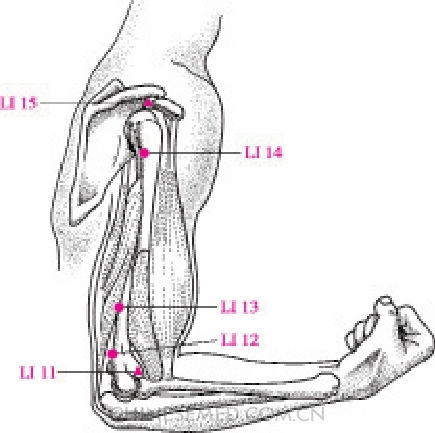
Annotation. The point appeared in TheSystematic Classic of Acupuncture and Moxibustion (Zhēn Jiŭ Jiă Yĭ Jīng, 针灸甲乙经). Zhǒu means elbow; liáo means hollow. The point is called zhǒu liáo because of its location in the depression above the elbow.
LI 13 (Shǒu Wǔ Lǐ, 手五里)
Location At the lateral aspect of the arm on a line connecting LI 11 (qū chí) with LI 15 (jiān yú), 3 cun superior to the cubital crease (Pic. 3-10).
Actions. Regulate qi and dissipate masses, dredge channels and activate collaterals.
Indications. Externally contracted diseases such as cough; distention, fullness, and pain of the stomach duct; hematemesis; fear and susceptibility to fright, somnolence; disorders of the running course such as arm swelling, pain, and paralysis; malaria, scrofula.
Manipulation. Acupuncture: Needle perpendicularly 0.5~1.0 cun to produce local soreness and distention that radiates to the shoulder or elbow. Moxibustion: Use 3~5 cones of cone moxibustion, or use warming needle moxibustion for 20 minutes, or use a moxa stick for 5~20 minutes.
Annotation. The point appeared in The Spiritual Pivot-Fundamental Points (Líng Shū-Bĕn Shū,灵枢·本输); it is called shǒu wǔ lǐ, arm fve mile, as it is a metaphorical fve miles above the elbow.
LI 14 (Bì Nào, 臂臑)
Intersecting point of the hand yangming, hand taiyang, foot taiyang, and yangwei channels
Location On the lateral aspect of the arm just anterior to the border of the deltoid muscle, 7 cun superior to LI 11 (qū chí) (Pic. 3-10).
Actions. Clear heat and improve vision, dispel wind and dredge collaterals.
Indications. Redness and pain in the eyes, blurred vision; disorders of the running course such as shoulder and arm pain and paralysis, spasm of the neck; scrofula.
Manipulation. Acupuncture: 1. Needle perpendicularly 0.5~1.0 cun to produce local soreness and distention that radiates to the forearm. 2. Needle obliquely 1.0~2.0 cun upward, penetrating the deltoid muscle to produce local soreness and distention that radiates to the shoulder. Moxibustion: Use 3~5 cones of cone moxibution, or use warming needle moxibustion for 20 minutes, or use a moxa stick for 10~20 minutes.
Annotation. The point appeared in The Systematic Classic of Acupuncture and Moxibustion (ZhēnJiŭ Jiă Yĭ Jīng, 针灸甲乙经). Náo means medial aspect of the upper arm; the point is named for its location at the medial aspect of the humerus.
LI 15 (Jiān Yú, 肩髃)
Intersecting point of the hand yangming, hand shaoyang, taiyang channels, and the yangqiao mai
Location On the shoulder girdle in the depression between the anterior end of lateral border of the acromion and the greater tubercle of the humerus (Pic. 3-11).
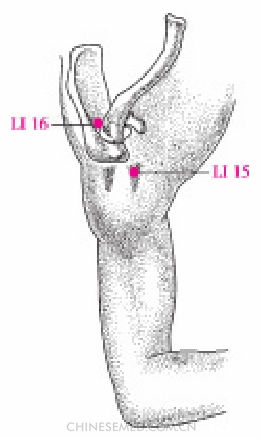
Location method. When the patient’s arm is abducted, the point can be found in the depression at the anterior border of the shoulder.
Actions. Ease joint movement and dispel wind-heat.
Indications. Shoulder and arm pain, spasm, and paralysis; scrofula, goiter, acute mastitis, wind-heat urticaria.
Manipulation. Acupuncture: 1. With the patient’s arm raised, needle perpendicularly 2~3 cun toward HT 1 (jí quán). Soreness and distention will radiate through the shoulder area or numbness will radiate to the arm. 2. To treat supraspinatus tendonitis, needle 1.0~ 1.5 cun between the acromion and major tubercle of the humerus with the arm dropped. At a depth of 2.0 cun, the supraspinatus will be penetrated. 3. To treat periarthritis of shoulder, needle 2.0~3.0 cun toward jian qian1, the point 1.5 cun superior to the anterior axillary fold; needle SJ 14 (jiān liáo) separately to produce local soreness and distention that radiates through the shoulder area or numbness that radiates to the arm. 4. Needle horizontally 2.0~3.0 cun, angling toward the deltoid to produce local soreness and distention. Moxibustion: Use 5~7 cones of cone moxibustion, or use warming needle moxibustion for 20 minutes, or use a moxa stick for 5~15 minutes.
Precautions. Scarring moxibustion is forbidden as a scar might limit the activity of the joint.
Annotation. The point appeared in The Spiritual Pivot-Channel Divergences (Líng Shū-Jīng Bié,灵枢·经别) and The Spiritual Pivot-Channels (Líng Shū-Jīng Mài, 灵枢·经脉). It is documented as an intersecting point in The Systematic Classic of Acupuncture and Moxibustion (Zhēn Jiŭ Jiă YĭJīng, 针灸甲乙经), Consideration of the Eight Extraordinary Vessels (Qí Jīng Bā Mài Kăo, 奇经八脉考), and Pictorial Appendices to ‘The classified Classic’ (Lèi Jīng Tú Yì, 类经图翼). The point is named for its location; yú means bone at the end of shoulder.
Modern clinical observation and research. In an RCT on chronic shoulder pain (n=424, CSP) outpatients received fifteen acupuncture (A), sham (S), or conventional (C) treatments over six weeks. Response was A 65%; S 24%; T 37% (P<0.01). Descriptive statistics showed greater improvement of shoulder mobility (abduction and arm-above-head test) for A versus control immediately after treatment and after three months.2
LI 16 (Jù Gǔ, 巨骨)
Intersecting point of the hand yangming and yangqiao channels
Location On the shoulder girdle in the depression between the acromial end of the clavicle and the mesoscapula (Pic. 3-11).
Actions. Dredge channels and activate collaterals.
1 It is an experienced point. The point is located in the anterior of the shoulder joint, in the midpoint of the line linking the tip of anterior axillar plica and LI 15 with a sitting posture and arm hanging down.
2 Molsberger AF, Schneider T, Gotthardt H, Drabik A. German Randomized Acupuncture Trial for chronic shoulder pain (GRASP)-a pragmatic, controlled, patient-blinded, multi-centre trial in an outpatient care environment. Pain. 2010; 151(1): 146-54.
Indications. Shoulder and arm pain, spasm, or paralysis; scrofula, goiter, hematemesis, windheat urticaria.
Manipulation. Acupuncture: 1. Needle perpendicularly 0.5~1.0 cun to produce local soreness and distention around the shoulder joint that can radiate to the clavicle or scapula. 2. Needle obliquely and laterally downward 1.0~1.5 cun to produce local soreness and distention around the joint.
Precautions. Deep perpendicular insertion is prohibited in order to avoid puncturing the lungs and causing pneumothorax.
Annotation. The point appeared in Basic Questions-Treatise on Qi Mansion (Sù Wèn-Qì Fŭ Lùn,素问·气府论). It is named for its location: jù means broad; jù gŭ means clavicle.
LI 17 (Tiān Dǐng, 天鼎)
Location On the anterior aspect of the neck at the level of the cricoid cartilage just posterior to the border of the sternocleidomastoid muscle (Pic. 3-12).
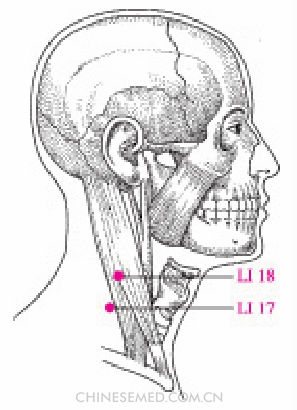
Location method. With the patient sitting upright and head tilted slightly upward, the point is 1 cun below LI 18 (fú tū).
Actions. Clear the throat, dissipate masses, regulate qi, and dissolve phlegm.
Indications. Cough, asthma, swollen and sore throat, sudden loss of voice, scrofula, goiter, plum-stone qi.
Manipulation. Acupuncture: Needle perpendicularly 0.3~ 0.5 cun to produce local soreness and distention that radiates to the throat. Moxibustion: Use 3~5 cones of cone moxibustion, or use a moxa stick for 5~10 minutes.
Precautions. Avoid vessels and nerves. To avoid the external superficial jugular vein, ask the patient to hold his/her breath slightly so the vein plumps up and can be seen clearly. To avoid other vessels, do not needle toward the anterior medial aspect. To avoid the brachial plexus and supraclavicular nerves, needle perpendicularly backward. If there is an electrical or radiating sensation after puncturing, change the direction, location, and depth of the needle to avoid piercing the nerves.
Annotation. The point appeared in The Systematic Classic of Acupuncture and Moxibustion (Zhēn Jiŭ Jiă Yĭ Jīng, 针灸甲乙经). Tiān means high place; dǐn⁝ is a three-legged cooking vessel. The point is named for its location below the divergence of the sternal and clavicular heads of the sternocleidomastoid muscle; the area looks like a standing dǐng.
LI 18 (Fú Tū, 扶突)
Location On the anterior aspect of the neck between the anterior and posterior borders of the sternocleidomastoid muscle at the level of the superior border of the thyroid cartilage (Pic. 3-12).
Location method. The point is 3 cun lateral to the laryngeal prominence between the sternal and clavicular heads of the sternocleidomastoid muscle.
Actions. Clear the throat, dissipate masses, regulate qi, and dissolve phlegm.
Indications. Cough, asthma, swollen and sore throat, phlegm rale in the lungs, sudden loss of voice, scrofula, goiter, plum-stone qi, bleeding tongue, hiccup.
Manipulation. Acupuncture: 1. Needle perpendicularly 0.5~0.8 cun to produce local soreness, tightness, and distention that radiates to the throat. 2. Needle perpendicularly about 5 fen toward the cervical vertebrae; an electrical sensation can radiate toward the hand. Avoid the vagus nerve by not penetrating too deeply. Moxibustion: Use 3~5 cones of cone moxibustion, or use a moxa stick for 5~10 minutes.
Precautions. See LI 17 (tiān dǐng).
Annotation. The point appeared in The Spiritual Pivot-Fundamental Points (Líng Shū-Bĕn Shū,灵枢·本输). Tū is a high place; fú is two people supporting each other. The point is named for its location between the muscle heads, which look like two people holding each other up.
LI 19 (Kǒu Hé Liáo, 口禾髎)
Location On the face, level with the midpoint of the philtrum and inferior to the lateral margin of the nostril (Pic. 3-13).

Location method. The point is 0.5 cun lateral to DU 26 (shuĭgōu).
Actions. Dispel wind and open the orifices.
Indications. Diseases of the local area such as nasal obstruction, runny nose, nosebleed, trismus.
Manipulation. Acupuncture: 1. Needle perpendicularly 0.3~0.5 cun to produce local soreness and distention. 2. Needle transversely 0.5~0.8 cun inward, penetrating DU 26 (shuĭ gōu) to produce local soreness and distention.
Annotation. The point appeared in The Systematic Classicof Acupuncture and Moxibustion (Zhēn Jiŭ Jiă Yĭ Jīng, 针灸甲乙经). Hé means grain; liáo means hollow. The point is called kǒu hé liáo because it is near the mouth where grain is consumed and corresponds to the depression between roots of the incisor and canine teeth.
LI 20 (Yín⁝ Xiān⁝, 迎香)
Intersecting point of the hand and foot yangming channels
Location On the face in the nasolabial sulcus, level with the midpoint of the lateral border of the ala of the nose (Pic. 3-13).
Actions. Open the orifices and dispel wind, regulate qi and relieve pain.
Indications. Nasal obstruction, inability to smell, nosebleed, sinusitis; facial itchiness, paralysis, and facial edema; ascariasis of the biliary tract.
Manipulation. Acupuncture: 1. Needle transversely 0.5~1.0 cun toward the medial superior aspect to produce local soreness and distention that radiates to the nose and sometimes tearing. 2. Needle transversely 1.0~1.5 cun toward the lateral superior aspect to penetrate ST 2 (sì bái) for ascariasis of the biliary tract. This will cause local soreness and distention that extends to the nose and sometimes will produce tearing.
Annotation. The point appeared in The Systematic Classic of Acupuncture and Moxibustion (ZhēnJiŭ Jiă Yĭ Jīng, 针灸甲乙经). It is called yíng xiāng, welcome fragrance, because it is beside the nose and can treat the inability to smell.
Modern clinical observation and research. In an RCT on TCM for allergic rhinitis, 135 patients were given acupuncture once a day at LI 20 and other front and back points, acupuncture at front points only, or four tablets of Bí Yán Kāng Piàn (鼻炎康片, a Chinese patent drug) three times a day. After two courses of ten treatments and at follow up six months later, effective rates were 91.1% in the first group; 71.1% in the second; 46.7% in the last; recurrence rates one year later were similar (P<0.05).1
Points of the Foot Yangming Stomach Channel
There are 45 bilateral points on the foot yangming stomach channel: 8 on the head; 2 on the neck; 20 on the anterior trunk; 15 on the antero-lateral side of the lower limb. The first is directly below the pupil of the eye within the infraorbital ridge, ST 1 (chéng qì); the last is on the lateral side of the second toe posterior to the corner of the nail, ST 45 (lì duì). The points of this channel treat disorders of the eyes, ears, mouth, nose, teeth, throat, stomach, intestines, and the running course of the channel.
ST 1 (Chéng Qì, 承泣)
Intersecting point of the foot yangming, ren, and yangqiao channels
Location On the face inferior to the pupil between the eyeball and the infraorbital ridge (Pic. 3-14).
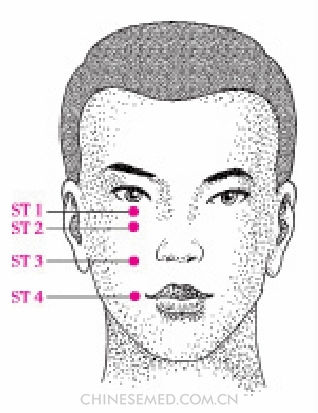
Actions. Dispel wind, clear heat, improve vision, and stop tearing.
Indications. Disorders and diseases of the eyes and face such as twitching of the eyelids, red and painful eyes, lacrimation upon exposure to wind, blurred vision, deviated mouth and eye, and night blindness.
Manipulation. Acupuncture: 1. With the patient’s eyes closed, push the eyeball slightly upward with the thumb and insert the needle slowly and perpendicularly 0.5~0.8 cun along the infraorbital ridge. It is not advisable to lift, thrust, or twirl the needle. 2. Needle transversely 0.5~0.8 cun toward the inner canthus. There may be local soreness and watering eyes.
Precautions. 1. Because there are many blood vessels around the point and it is easy to cause bleeding, the needle should be inserted slowly without lifting, thrusting, or twirling to prevent injuring the eyeball or causing hematoma. After withdrawing the needle, apply pressure on the site to prevent bleeding. 2. Avoid inserting obliquely or too deeply. 3. Moxibustion is forbidden.
Annotation. The point is recorded in The Systematic Classic of Acupuncture and Moxibustion (Zhēn Jiŭ Jiă Yĭ Jīng, 针灸甲乙经). Chéng means hold; qì means tears. This point is located 7 fen below the pupil, which means that it catches the tears.
1 Chen ZX. Clinical observation on acupuncture for treatment of allergic rhinitis针刺治疗过敏性鼻炎疗效观察. Chinese Acupuncture & Moxibustion. 2007; 27(8): 578-80.
Modern clinical observation and research. In a case series, ST 1 (chéng qì) was used to treat orbicularis muscle spasm. The needle was inserted perpendicularly 0.3~0.7 cun, twirled, retained for 30 minutes, and manipulated every 5 minutes. Treatment was performed once a day; three treatments constituted a course. Of 22 cases, 18 (81.8%) fully recovered; eyelid twitching frequency obviously decreased in 3 (13.6%); there was no improvement in 1 (4.5%).1
ST 2 (Sì Bái, 四白)
Location On the face in the infraorbital foramen (Pic. 3-14).
Actions. Disperse wind, improve vision, dredge channels, and activate collaterals.
Indications. Red and painful eyes, lacrimation upon exposure to wind, superficial visual obstruction, deviation of the mouth and eye; headache, vertigo.
Manipulation. Acupuncture: 1. Needle perpendicularly 0.5~0.8 cun to produce local soreness. 2. Needle obliquely upward 0.5 cun toward the infraorbital foramen. Numbness and electrical sensations can radiate to the upper lip.
Precautions. Moxibustion is not advisable.
Annotation. The point is recorded in The Systematic Classic of Acupuncture and Moxibustion (Zhēn Jiŭ Jiă Yĭ Jīng, 针灸甲乙经). Sì means the four directions, which indicates a wide area; bái means white. Because this point can improve vision, enabling one to see in all directions, it is called sì bái.
ST 3 (Jù Liáo, 巨髎)
Intersecting point of the foot yangming and yangqiao channels
Location On the face directly inferior to the pupil at the level of the inferior border of the ala of the nose (Pic. 3-14).
Actions. Clear and extinguish the wind, and remove nebula to improve vision.
Indications. Deviation of mouth and eye, twitching of the eyelids, superficial visual obstruction, nosebleed, toothache, swollen lip and cheek.
Manipulation. Acupuncture: 1. Needle perpendicularly 0.3~0.6 cun to produce local soreness. 2. Needle toward ST 6 (jiá chē) to treat facial paralysis. 3. Needle toward the pupil or ST 2 (sìbái) on the same side to treat facial paralysis, superficial visual obstruction, and short sightedness. Moxibustion: Use warming needle moxibustion for 20 minutes, or use a moxa stick for 5~10 minutes.
Annotation. The point is recorded in The Systematic Classic of Acupuncture and Moxibustion (Zhēn Jiŭ Jiă Yĭ Jīng, 针灸甲乙经). Jù means huge; liáo refers to a depression. This point is named jù liáo for its location in the depression below the medial border of the zygomatic bone.
ST 4 (Dì Cāng, 地仓)
Intersecting point of the hand and foot yangming and yangqiao channels
Location On the face, 0.4 cun lateral to the angle of the mouth (Pic. 3-14).
Location method. With the patient sitting upright or supine and with eyes looking straight ahead, the point is at the intersection of a vertical line from the pupil and a horizontal line from the angle of the mouth.
Actions. Dispel wind, relieve pain, relax sinews, and quicken collaterals.
Indications. Flaccid lips that will not contract, deviation of mouth and eye, excessive salivation, toothache, facial pain.
1 Zhao AW, Chen GY. Puncturing ST 1 (chéng qì) to treat 22 cases of orbicularis muscle spasm针刺承泣穴治疗眼轮匝肌痉挛22例. The People’s Military Medical Press. 2004; 47(11): 682.
Manipulation. Acupuncture: 1. Needle perpendicularly 0.2 cun. 2. Needle 1.0~2.5 cun toward ST 6 (jiá chē) to treat facial paralysis. 3. Needle toward LI 20 (yíng xiāng) to treat facial pain. Local soreness can spread to half of the face; there might be a pulling sensation at the angle of the mouth. Moxibustion: Use warming needle moxibustion for 20 minutes, or use natural medicinal moxibustion.
Precautions. Moxa cone moxibustion is forbidden.
Annotation. The point is recorded in The Systematic Classic of Acupuncture and Moxibustion (Zhēn Jiŭ Jiă Yĭ Jīng, 针灸甲乙经). Dì means earth; cāng means granary. The ancients divided the face into three regions: above the nose is the upper hall; the nose is the middle hall; below the nose is the lower hall. These are also called the regions of ‘heaven’, of ‘people’, and of ‘earth’. This point is under the nose in the earthly region near the mouth, where food enters the body. Metaphorically, the mouth is a granary, so the point is called dì cāng.
ST 5 (Dà Yíng, 大迎)
Location On the face anterior to the angle of the mandible in the anterior border of the masseter and above the facial artery (Pic. 3-15).
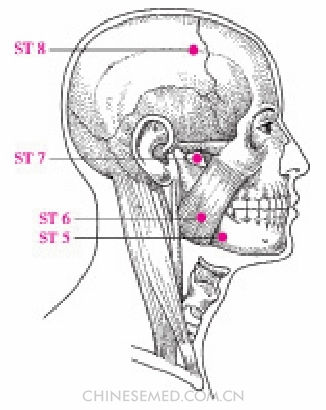
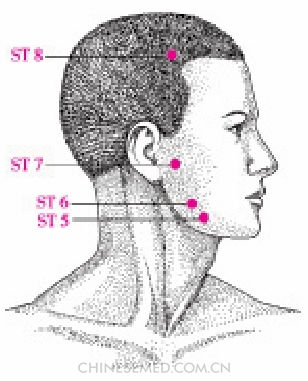
Location method. With the patient upright or supine with mouth closed and cheeks puffed, the point is in the groove at the edge of the mandible where the facial artery pulsates.
Actions. Expel wind, dredge collaterals, reduce swelling, and relieve pain.
Indications. Flaccid lips, deviation of the angle of the mouth, trismus, excessive salivation, swelling of the cheek, toothache.
Manipulation. Acupuncture: Needle perpendicularly 0.2~0.5 cun. Local soreness can spread to half of the face. Moxibustion: Use warming needle moxibustion for 20 minutes, or use a moxa stick for 10~20 minutes.
Precautions. Avoid the artery and veins to prevent bleeding. When needling, locate the artery; insert the needle 0.3~0.5 cun along its edge.
Annotation. The point is recorded in The Spiritual Pivot-Cold and Febrile Diseases (Líng Shū-HánRè Bìng, 灵枢·寒热病). Yíng means welcoming and receiving. The throbbing of the facial artery can be felt when palpating this point, so this point ‘welcomes all sensations’ and is called dà yíng.
ST 6 (Jiá Chē, 颊车)
Location On the face one fingerbreadth (middle finger) anterosuperior to the angle of the mandible (Pic. 3-15).
Location method. The point is at the prominence of the masseter muscle when the teeth are clenched. When the teeth are relaxed, there is a depression at the spot when pressed.
Actions. Expel wind, clear heat, unblock the joints and collaterals.
Indications. Local disorders such as deviation of the mouth, clenched teeth, swollen cheeks, toothache.
Manipulation. Acupuncture: 1. Needle perpendicularly 0.3~0.5 cun or transversely 0.5~ 0.8 cun. Local soreness can spread to the surrounding region. 2. Needle transversely 1.0~2.0 cun toward ST 4 (dì cāng) to treat facial paralysis. The needle stagnating method may be used; this involves twirling the needle in one direction as far as it will go, then holding the handle and dragging it toward the diseased side. 3. Needle obliquely 0.5~0.8 cun upward or downward to treat upper and lower toothache. Local soreness can spread to the surrounding region. Moxibustion: Use warming needle moxibustion for 20 minutes, or use a moxa stick for 10~20 minutes, or natural medicinal moxibustion.
Annotation. The point is recorded in The Spiritual Pivot-Channels (Líng Shū-Jīng Mài, 灵枢·经脉). It gets its name from the mandible, which was formerly called the jiá chē bone.
Modern clinical observation and research. In a case series (n=63) on pericoronitis of the wisdom tooth, differentiated as toothache due to stomach fire, EA was given at ST 7 (xià guān) and ST 6 (jiá chē); acupuncture, at LI 4 (hé gŭ) and ST 44 (nèi tíng). The diseased side was treated twice a day. Three treatments constituted a course; after one, 16 patients fully recovered; 39 showed significant improvement; 5 improved. Treatment was ineffective for 3.1
ST 7 (Xià Guān, 下关)
Intersecting point of the foot yangming and foot shaoyang channels
Location On the face in the depression between the midpoint of the inferior border of the zygomatic arch and the mandibular notch (Pic. 3-15).
Location method. The point is on the lower border of the zygomatic bone, slightly anterior to the condyloid process of the mandible. Locate with the patient’s mouth closed.
Actions. Clear the head, improve vision, and relieve pain and convulsion.
Indications. Trismus, deviated mouth or eyes, temporomandibular disorders, facial pain; deafiness, tinnitus, ear infection.
Manipulation. Acupuncture: 1. Needle perpendicularly and slightly downward 1.0~1.5 cun to treat trigeminal neuralgia. Local soreness or numbness and electrical sensations radiate to the mandible. 2. For ear disorders, needle obliquely toward the back 1.0~1.5 cun, inducing soreness that spreads to the ear. 3. For toothache, needle transversely 1.5~2.0 cun toward the upper or lower teeth, inducing soreness that spreads to the teeth. 4. Treat temporomandibular disorders by triple needling. Moxibustion: Use warming needle moxibustion for 20 minutes, or use a moxa stick for 10~20 minutes, or natural medicinal moxibustion.
Precautions. Cone moxibustion is forbidden.
1 Luo DQ, Sun YX. Clinical observation of 63 cases of toothache due to stomach fre treated with ST 7 (xià guān) and ST 6 (jiá chē) using electroacupuncture电针下关、颊车为主治疗牙齩痈胃火牙痛63例临床观察. Jiangsu Journal of Traditional Chinese Medicine. 2008; 40(5): 58-9.
Annotation. The point is recorded in The Spiritual Pivot-Fundamental Points (Líng Shū-Běn
Shū, 灵枢·本输). Xià means lower; guān means hinge. The point is inferior to the hinge of the jaw; thus it is called lower hinge.
ST 8 (Tóu Wéi, 头维)
Intersecting point of the foot yangming, foot shaoyang, and yangwei channels
Location On the head 0.5 cun directly superior to the anterior hairline at the corner of the forehead, 4.5 cun lateral to the anterior median line (Pic. 3-15).
Actions. Clear the head, improve vision, relieve pain and convulsion.
Indications. Migraine, headache, dizziness, eye pain, lacrimation upon exposure to wind, blurred vision, twitching of the eyelids.
Manipulation. Acupuncture: 1. Needle transversely 0.5~0.8 cun backward. Local soreness can spread to the surrounding region. Moxibustion: Use 3~5 cones of indirect moxibustion, or use a moxa stick for 5~10 minutes.
Precautions. Direct moxibustion is forbidden.
Annotation. The point is recorded in The Systematic Classic of Acupuncture and Moxibustion (Zhēn Jiŭ Jiă Yĭ Jīng, 针灸甲乙经). Wéi means protect. Foot yangming channel qi traverses and protects the anterior side of the body, giving the point its name, tóu wéi.
Modern clinical observation and research. In a case series on ST 8 (tóu wéi) for migraine, a needle was inserted 25~30 mm from the anterior to the posterior on the diseased side; another was inserted transversely so that the needles crossed. They were twirled rapidly and retained for an hour. GB 20 (fēng chí), LI 4 (hé gŭ), and LV 3 (tài chōng) were added and retained for 30 minutes. Treatment was given once or twice a week for four weeks until the pain was relieved. Of 32 patients, 13 fully recovered and 16 improved. Treatment was unsuccessful in 3 cases.1
ST 9 (Rén Yíng, 人迎)
Intersecting point of the foot yangming and foot shaoyang channels
Location In the anterior region of the neck level with the superior border of the thyroid cartilage, anterior to the sternocleidomastoid muscle and above the common carotid artery (Pic. 3-16).
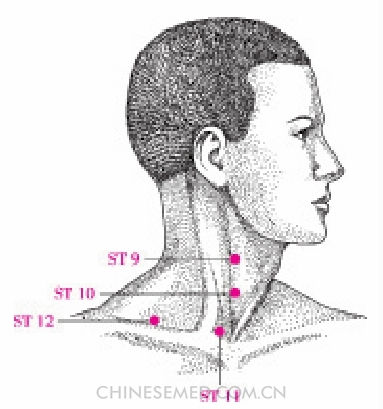
Location method. To locate the point, ask the patient to turn the head to the opposite side to reveal the sternocleidomastoid muscle. The muscle will be more prominent when the head is turned with resistance applied at the chin. The point is lateral to the laryngeal prominence where the artery pulsates. Avoid the artery when needling.
Actions. Clear the pharynx, dissipate masses, rectify qi, and direct counterflowing qi downward.
Indications. Chest fullness, qi counterflow, asthma, cough; swollen and sore throat, scrofula, goiter, vomiting, difficulty in swallowing; hypert.
1 Cheng RM. Thirty-two cases of migraine treated by crossing acupuncture at ST 8 (tóu wéi) 头维十字刺治疗偏头痛32例. Shaanxi Journal of Traditional Chinese Medicine. 2007; 28(8): 1067-8.
Manipulation. Acupuncture: Needle perpendicularly 0.3~0.5 cun; avoid needling the artery. Local soreness might spread to the shoulders.
Precautions. 1. Needling the point with the patient in a sitting position can decrease oxygen to the brain; supine position is recommended. 2. When needling the carotid sinus, avoid strong stimulation to prevent collapse, vertigo, sweating, and decrease in blood pressure caused by hyperrefexia of the sinus. 3. The vagus nerve is behind the common and internal carotid arteries. Avoid puncturing the nerve. 4. Strong lifting and thrusting can injure the vessels. 5. Scarring moxibustion is forbidden as the point is located near major blood vessels.
Annotation. The point is recorded in The Spiritual Pivot-Fundamental Points (Líng Shū-BěnShū, 灵枢·本输). It got its name because it is located where the renying pulse is felt.
ST 10 (Shuĭ Tū, 水突)
Location In the anterior region of the neck at the level of the cricoid cartilage, just anterior to the sternocleidomastoid muscle (Pic. 3-16).
Location method. With the patient leaning back, the point is on the lateral edge of the thyroid cartilage at the anterior border of the sternocleidomastoid muscle.
Actions. Clear heat, clear the pharynx, direct qi counterflow downward, and relieve cough.
Indications. Chest fullness, qi counterflow, wheezing, cough, gasping; sore and swelling throat, scrofula, goiter, vomiting, difficulty swallowing.
Manipulation. Acupuncture: Needle perpendicularly 0.3~0.4 cun to produce local soreness. Do not needle too deeply. Adopt multiple-needle acupuncture to treat swelling of the thyroid to produce local soreness and heaviness. Moxibustion: Use 3~5 cones or a moxa stick for 5~10 minutes.
Precautions. 1. Avoid the vessels and epineuria in the neck. With one fnger, fnd the throbbing of the vascular nerve sheath; with the other hand insert a needle beside the sheath. Do not needle too deeply or you might injure the common carotid artery and the branches of the external carotid artery. 2. To prevent piercing the thyroid gland, do not needle medially.
Annotation. The point is recorded in The Systematic Classic of Acupuncture and Moxibustion (Zhēn Jiŭ Jiă Yĭ Jīng, 针灸甲乙经). Shuǐ means water; tū means protrusion. The area of the point protrudes outward when an individual ingests food or water, giving the point the name shuǐ tū.
ST 11 (Qì Shè, 气舍)
Location In the lesser supraclavicular fossa superior to the sternal end of the clavicle in the depression between the sternal and clavicular heads of the sternocleidomastoid muscle (Pic. 3-16).
Location method. With the patient sitting upright and leaning back, the point is directly inferior to ST 9 (rén yíng) on the superior border of the medial side of the clavicle, 1.5 cun from RN 22 (tiān tū).
Actions. Clear the pharynx and lung, rectify qi, and dissipate masses.
Indications. Chest distention, counterflow of qi, asthma, cough; swollen and sore throat, goiter, scrofula, vomiting, difficulty ingesting; headache, stiff neck.
Manipulation. Acupuncture: Needle perpendicularly 0.3~0.5 cun to produce local soreness. Moxibustion: Use 3~5 cones of cone moxibustion, or use a moxa stick for 5~10 minutes.
Precautions. The needle should reach the muscular layer but not penetrate it. Deep insertion can cause bleeding or pierce lymph vessels. Deep insertion towards the posterolateral side can puncture the apex of the lung, leading to bleeding or pneumothorax.
Annotation. The point is recorded in The Systematic Classic of Acupuncture and Moxibustion (Zhēn Jiŭ Jiă Yĭ Jīng, 针灸甲乙经). Shè means house. This point is where the foot yangming stomach channel qi infuses and resides, hence the name ‘qi house’.
ST 12 (Quē Pén, 缺盆)
Location In the greater supraclavicular fossa, 4 cun lateral to the anterior median line in the depression superior to the clavicle (Pic. 3-16).
Actions. Relieve stuffiness of chest and diaphragm, coughing, and panting.
Indications. Coughing of blood, chest distention, qi counterflow, asthma, cough, swollen and sore throat, pain in the supraclavicular fossa; scrofula.
Manipulation. Acupuncture: Needle perpendicularly 0.3~0.5 cun. Local soreness can spread to the upper arm. Moxibustion: Use 3~5 cones of cone moxibustion, or use a moxa stick for 5~10 minutes.
Precautions. Deep insertion can cause pneumothorax. To avoid the external jugular veins, instruct the patient to hold the breath to allow the veins to be seen clearly. To prevent piercing the apex of lung causing bleeding or pneumothorax, do not needle toward the medial-inferior side.
Annotation. The point is recorded in Basic Questions-Treatise on Qi Mansion (Sù Wèn-Qì FǔLùn, 素问·气府论). It is located in the supraclavicular fossa, which looks like a broken pot.
ST 13 (Qì Hù, 气户)
Location On the anterior thorax inferior to the clavicle, 4 cun lateral to the anterior median line (Pic. 3-17a, b).
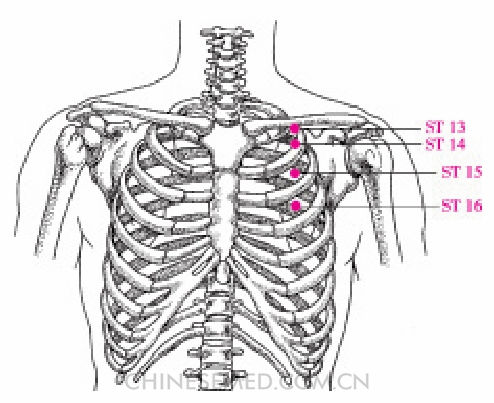
Actions. Rectify qi, relieve stuffiness of the chest, relieve cough, and calm panting.
Indications. Cough, asthma, hiccup, fullness and discomfort in the chest and ribs; chest pain.
Manipulation. Acupuncture: Needle obliquely or transversely 0.5~0.8 cun to produce local soreness. Moxibustion: Use 3~5 cones of cone moxibustion, or use a moxa stick 5~10 minutes.
Precautions. Deep insertion is prohibited. Insert the needle close to the inferior border of the clavicle and laterally toward the back. Do not needle medially toward the back.
Annotation. The point is recorded in The Systematic Classic of Acupuncture andMoxibustion (Zhēn Jiŭ Jiă Yĭ Jīng, 针灸甲乙经). Qì hù means ‘door where qi enters and exits’.
ST 14 (Kù Fáng, 库房)
Location On the anterior thorax 4 cun lateral to the anterior median line in the first intercostal space (Pic. 3-17a, b).
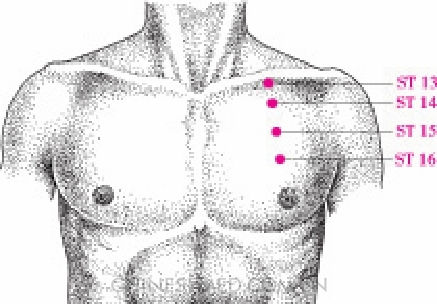
Actions. Rectify qi, relieve stuffiness of the chest, clear heat, and eliminate phlegm.
Indications. Chest distention and pain, qi counterflow, asthma, chest and rib pain, cough, coughing of purulent blood.
Manipulation. Acupuncture: Needle obliquely or transversely 0.5~0.8 cun to produce local soreness.
Precautions. Piercing the thoracic cavity will injure the pleura and lung. Needle along the long axis of the first rib, not perpendicularly. To avoid piercing the vein and causing bleeding, do not insert the needle obliquely into the axillary cavity toward the posterolateral side.
Annotation. The point is recorded in The Systematic Classic of Acupuncture and Moxibustion (Zhēn Jiŭ Jiă Yĭ Jīng, 针灸甲乙经). Kù means storage; fáng means room. This point is below ST 13 (qì hù); its name implies that channel qi has moved gradually deeper, from the door into the room.
ST 15 (Wū Yì, 屋翳)
Location On the anterior 4 cun lateral to the anterior median line thorax in the second intercostal space (Pic. 3-17a, b).
Actions. Relieve cough, dissolve phlegm, eliminate abscesses, and relieve itching.
Indications. Distention and pain in the chest, qi counterflow, asthma, chest and rib pain, coughing purulent blood; acute mastitis, breast lumps.
Manipulation. Acupuncture: Needle perpendicularly 0.2~0.3 cun or obliquely inward 0.5~0.8 cun. There will be local soreness. Moxibustion: Use 3~5 cones of cone moxibustion, or use a moxa stick for 5~10 minutes.
Precautions. Be careful when using this point on pregnant or lactating patients; see ST 14 (kùfáng).
Annotation. The point is recorded in The Systematic Classic of Acupuncture and Moxibustion (Zhēn Jiŭ Jiă Yĭ Jīng, 针灸甲乙经). Wū means room; yì means covering shade or screen. This point, below ST 14 (kù fáng) and above ST 16 (yīng chuāng), is like the eaves of a house; thus its name is wū yì.
ST 16 (Yīng Chuāng, 膺窗)
Location On the anterior thorax region 4 cun lateral to the anterior median line in the third intercostal space (Pic. 3-17a, b).
Actions. Relieve cough, eliminate swelling, and clear heat.
Indications. Chest distention and pain, counterflow of qi, asthma; acute mastitis.
Manipulation. Acupuncture: Needle perpendicularly 0.2~0.4 cun or obliquely 0.5~0.8 cun medially.
Precautions. See ST 15 (wū yì).
Annotation. The point is recorded in The Systematic Classic of Acupuncture and Moxibustion (Zhēn Jiŭ Jiă Yĭ Jīng, 针灸甲乙经). Yīng means chest; chuāng means window. This point, on the upper border of the mammary areola, is considered to be the orifce of lactation.
ST 17 (Rǔ Zhōng, 乳中)
Location On the anterior thorax at the center of the nipple (Pic. 3-18).
Actions. Rectify qi and induce resuscitation.
Indications. This point serves only as a landmark for locating points on the chest and the abdomen.
Manipulation. Acupuncture and moxibustion are prohibited.
Annotation. The point is recorded in TheSystematic Classic of Acupuncture and Moxibustion (Zhēn Jiŭ Jiă Yĭ Jīng, 针灸甲乙经). Rǔ means breast; zhōng means middle. This point gets its name from its location at the center of the nipple.

ST 18 (Rǔ Gēn, 乳根)
Location On the anterior thorax region 4 cun lateral to the anterior median line in the fifth intercostal space (Pic. 3-18).
Location method. In males the point is one rib below the nipple where the midline of the breast intersects with the fifth intercostal space. In females it is at the midpoint of the arc of the root of the breast.
Actions. Stimulate lactation, dissolve stasis, diffuse the lung, and benefit qi.
Indications. Insufficient lactation, acute mastitis, breast lumps; chest pain and stuffiness, cough.
Manipulation. Acupuncture: Needle obliquely upward or laterally 0.5~0.8 cun. Local soreness can spread to the breast. Moxibustion: Use 5~9 cones of cone moxibustion, or use a moxa stick for 10~20 minutes.
Precautions. See ST 15 (wū yì).
Annotation. The point is recorded in The Systematic Classic of Acupuncture and Moxibustion (Zhēn Jiŭ Jiă Yĭ Jīng, 针灸甲乙经). It is named rǔ gēn for its location.
ST 19 (Bù Róng, 不容)
Location On the upper abdomen 6 cun superior to the center of the umbilicus, 2 cun lateral to the anterior median line (Pic. 3-19).
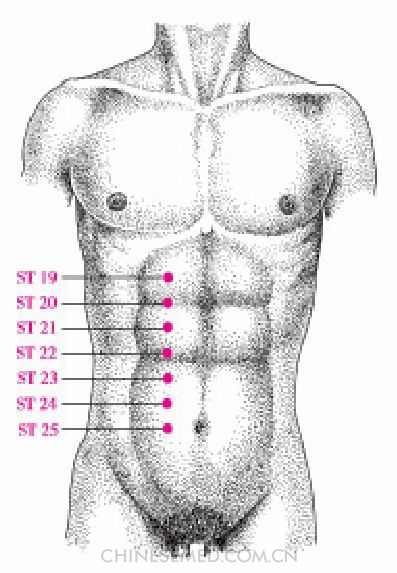
Actions. Regulate the center, harmonize the stomach, rectify qi, and relieve pain.
Indications. Vomiting, stomachache, abdominal distention, poor appetite, vomiting blood.
Manipulation. Acupuncture: Needle obliquely 0.5~1.0 cun. There will be local soreness. Moxibustion: Use 3~5 cones of cone moxibustion, or use warming needle moxibustion for 20 minutes, or use a moxa stick for 5~10 minutes.
Precautions. The patient’s body fat should be considered when needling this point; to avoid injuring the liver and stomach, the needle should not penetrate the parietal peritoneum to enter the abdominal cavity. In those with smaller xiphoid angles, the rib might be just below the point, so transverse insertion is advised. Needling is not advisable in those who have recently eaten a heavy meal or those with hepatomegaly.
Annotation. The point is recorded in The Systematic Classic of Acupuncture and Moxibustion (Zhēn Jiŭ Jiă Yĭ Jīng, 针灸甲乙经). Bù means not; róng means accommodate. The point is considered to be so flled with water and grain that it cannot accommodate more, and it corresponds to the upper orifce of the stomach and can treat abdominal fullness of the abdomen, so it is named bù róng.
ST 20 (Chéng Mǎn, 承满)
Location On the upper abdomen 5 cun superior to the center of the umbilicus, 2 cun lateral to the anterior median line (Pic. 3-19).
Actions. Rectify qi, harmonize the stomach, direct counterflowing qi downward, and arrest vomiting.
Indications. Vomiting, stomachache, abdominal distention, poor appetite, borborygmus, vomiting blood.
Manipulation. Acupuncture: Needle perpendicularly 0.5~0.8 cun. There will be sensations of heaviness and distention in the upper abdomen. Moxibustion: Use 3~5 cones of cone moxibustion, or use warming needle moxibustion for 20 minutes, or use a moxa stick for 5~10 minutes.
Precautions. See ST 19 (bù róng).
Annotation. The point is recorded in The Systematic Classic of Acupuncture and Moxibustion (Zhēn Jiŭ Jiă Yĭ Jīng, 针灸甲乙经). It is located below ST 19 (bù róng) and above the stomach, which implies that it is saturated with water and grain. This point is also responsible for obstructive sensations in the epigastrium; thus it is called supporting fullness, chéng mǎn.
ST 21 (Liáng Mén, 梁门)
Location On the upper abdomen 4 cun superior to the center of the umbilicus, 2 cun lateral to the anterior median line (Pic. 3-19).
Actions. Harmonize the stomach, regulate qi, invigorate the spleen, and regulate the center.
Indications. Vomiting, stomachache, abdominal distention, poor appetite, borborygmus, loose stool, vomiting blood.
Manipulation. Acupuncture: Needle perpendicularly 0.5~1.0 cun to produce local soreness and heaviness in the stomach. Moxibustion: Use 3~5 cones of cone moxibustion, or use warming needle moxibustion for 20 minutes, or use a moxa stick for 5~10 minutes.
Precautions. The patient’s body fat should be considered when puncturing this point; do not penetrate the parietal peritoneum to avoid piercing the abdominal cavity and injuring the organs.
Annotation. The point is recorded in The Systematic Classic of Acupuncture and Moxibustion (Zhēn Jiŭ Jiă Yĭ Jīng, 针灸甲乙经). Liáng means wooden beam; mén means gate. An accumulated mass at the epigastrium is known as liáng, and an accumulated mass between the umbilicus and epigastrium is like a supporting beam. This point can resolve accumulation and stagnation; it is an important gate through which stomach qi enters and exits, so it is called liáng mén.
ST 22 (Guān Mén, 关门)
Location On the upper abdomen 3 cun superior to the center of the umbilicus, 2 cun lateral to the anterior median line (Pic. 3-19).
Actions. Regulate stomach and intestines, and drain water to alleviate edema.
Indications. Vomiting, stomachache, abdominal distention, poor appetite, borborygmus, vomiting blood; enuresis, edema.
Manipulation. Acupuncture: Needle perpendicularly 1.0~1.5 cun. There will be local soreness and heaviness. Moxibustion: Use 3~5 cones of cone moxibustion, or use warming needle moxibustion for 20 minutes, or use a moxa stick for 5~10 minutes.
Precautions. See ST 21 (liáng mén).
Annotation. The point is recorded in The Systematic Classic of Acupuncture and Moxibustion (Zhēn Jiŭ Jiă Yĭ Jīng, 针灸甲乙经). Located 1 cun below ST 21 (liáng mén), like ST 21, it is important in the transportation of body fuids by the stomach and is a gate through which stomach qi enters and exits. Thus it is called guān mén, past gate.
ST 23 (Tài Yǐ, 太乙)
Location On the upper abdomen 2 cun superior to the umbilicus, 2 cun lateral to the anterior median line (Pic. 3-19).
Actions. Clear phlegm to open the orifices, calm fright, tranquilize the mind, invigorate the spleen, reinforce qi, and harmonize the stomach to aid digestion.
Indications. Vomiting, stomachache, abdominal distention, poor appetite, borborygmus, vomiting blood; vexation, psychosis.
Manipulation. Acupuncture: Needle perpendicularly 1.0~1.5 cun. There will be local soreness and heaviness. Moxibustion: Use 3~5 cones of cone moxibustion, or use warming needle moxibustion for 20 minutes, or use a moxa stick for 5~10 minutes.
Precautions. Avoid penetrating the parietal peritoneum. Entering the abdominal cavity can injure the greater omentum or small intestine.
Annotation. The point is recorded in The Systematic Classic of Acupuncture and Moxibustion (Zhēn Jiŭ Jiă Yĭ Jīng, 针灸甲乙经). Tài means unobstructed in this instance; yǐ means winding. This point is on the abdomen above the winding small intestine. The intestines must be unobstructed to ensure normal physiological functions; as this point can treat intestinal disorders, it is called tài yǐ.
ST 24 (Huá Ròu Mén, 滑肉门)
Location On the upper abdomen 1 cun superior to the umbilicus, 2 cun lateral to the anterior median line (Pic. 3-19).
Actions. Clear phlegm and open the orifices, calm fright, tranquilize mind, rectify qi to harmonize the stomach, and direct counterflowing qi downward to arrest vomiting.
Indications. Vomiting, stomachache, abdominal distention, poor appetite, borborygmus, ascites, vomiting blood; psychosis.
Manipulation. Acupuncture: Needle perpendicularly 1.0~1.5 cun. Local soreness can spread downward. Moxibustion: Use 3~5 cones of cone moxibustion, or use warming needle moxibustion for 20 minutes, or use a moxa stick for 5~10 minutes.
Precautions. See ST 23 (tài yǐ).
Annotation. The point is recorded in The Systematic Classic of Acupuncture and Moxibustion (Zhēn Jiŭ Jiă Yĭ Jīng, 针灸甲乙经). Huá means to facilitate, ròu means muscle, and mén means gate. The spleen and the yangming govern the muscles. This point treats disorders of the spleen and stomach and is the gate that facilitates the functions of those organs, so it is called huá ròu mén.
ST 25 (Tiān Shū, 天枢)
Front-mu point of the large intestine
Location On the upper abdomen 2 cun lateral to the center of the umbilicus (Pic. 3-19).
Actions. Regulate the center, harmonize the stomach, regulate qi, and invigorate the spleen.
Indications. Vomiting, vomiting blood, poor appetite, indigestion, cutting pain around the navel, abdominal distention, borborygmus, diarrhea, dysentery, constipation, intestinal abscess, hernia; irregular menstruation, dysmenorrhea, amenorrhea, flooding and spotting, postpartum abdominal pain; bipolarism, epilepsy, and insomnia; headache, dizziness, difficult urination, urticaria.
Manipulation. Acupuncture: 1. Needle perpendicularly 1.0~1.5 cun. Local soreness can spread to the abdomen on the same side. 2. Needle obliquely with the needle angled slightly upward. The needling sensation can ascend along the foot yangming stomach channel. 3. Needle obliquely with the needle slightly toward ST 28 (shuǐ dào). The needling sensation can descend along the foot yangming stomach channel. Moxibustion: Use 5~10 cones of cone moxibustion, or use warming needle moxibustion for 20 minutes, or use a moxa stick for 15~30 minutes. Moxibustion may be performed until the skin feels warm and comfortable or turns slightly red to strengthen the body and to preserve health.
Precautions. Insert the needle slowly; do not lift and thrust too quickly or forcibly to prevent perforating the intestinal tract, especially in patients with enteroparalysis and a lack of peristalsis. Needling depth is determined by the thickness of the abdominal wall. The principle is to avoid puncturing the parietal peritoneum.
Annotation. The point is recorded in The Spiritual Pivot-Measurements of the Bone (LíngShū-Gŭ Dù, 灵枢·骨度). Tiān means heaven; shū means pivot. The region above the umbilicus corresponds to heaven; that below corresponds to earth. The point is beside the umbilicus on the dividing line between upper and lower abdomen. It connects with the middle jiao, mediates the top and bottom regions, and coordinates ascending and descending movements, so it is called tiān shū.
Modern clinical observation and research. To study the effects of deep and shallow insertion at ST 25 (tiān shū) in functional constipation, needles were inserted 45 mm or 5mm and connected to an EA device so that abdominal muscles vibrated slightly and patients felt slight pain. Treatment was once a day, fve times a week; four weeks constituted a course. Deep insertion was more effective in increasing bowel movement frequency and reducing constipation. The effects lasted for some time after treatment stopped.1
ST 26 (Wài Líng, 外陵)
Location On the lower abdomen 1 cun inferior to the center of the umbilicus, 2 cun lateral to the anterior median line (Pic. 3-20).
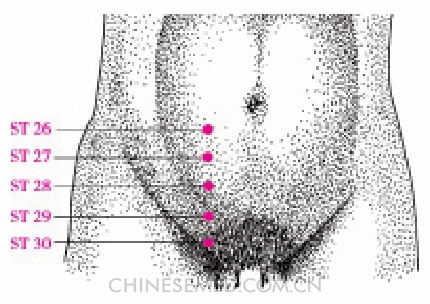
Actions. Harmonize stomach, resolve dampness, regulate qi, and relieve pain.
Indications. Abdominal pain and distention, hernia; dysmenorrhea, menstrual irregularities.
1 Wang CW, He HB, Li N,Wen Q, Liu ZS. Randomized controlled trials of electroacupuncture with deep needling at ST 25 (tiān shū) in functional constipation电针深刺天枢穴治疗功能性便秘随机对照研究. Chinese Acupuncture & Moxibustion. 2010; 30(9): 705-8.
Manipulation. Acupuncture: Needle perpendicularly 1.0~1.5 cun. Local soreness can spread downward. Moxibustion: Use 3~5 cones of cone moxibustion, or use warming needle moxibustion for 20 minutes, or use a moxa stick for 5~10 minutes.
Precautions. See ST 25 (tiān shū).
Annotation. The point is recorded in The Systematic Classic of Acupuncture and Moxibustion (Zhēn Jiŭ Jiă Yĭ Jīng, 针灸甲乙经). Wài means outside and refers to the area lateral to the anterior midline; ling means a high protrusion. Because this point is lateral and inferior to the umbilicus at the protrusion of the rectus abdominis muscle, it is called wài líng.
ST 27 (Dà Jù, 大巨)
Location On the lower abdomen 2 cun inferior to center of the umbilicus, 2 cun lateral to the anterior median line (Pic. 3-20).
Actions. Regulate intestines and stomach and reinforce kidney qi.
Indications. Lower abdominal distention, hernia; difficulty in urinating; spermatorrhea, premature ejaculation, impotence; dysmenorrhea, menstrual irregularities.
Manipulation. Acupuncture: Needle perpendicularly 1.0~1.5 cun to produce local soreness that can spread downward. Moxibustion: Use 3~5 cones of cone moxibustion, or use warming needle moxibustion for 20 minutes, or use a moxa stick for 10~20 minutes.
Precautions. See ST 25 (tiān shū).
Annotation. The point is recorded in The Systematic Classic of Acupuncture and Moxibustion (Zhēn Jiŭ Jiă Yĭ Jīng, 针灸甲乙经). Dà and jù both mean big or great. This point is on the large protruding area of the rectus abdominis muscle, so it was named dà jù.
ST 28 (Shuǐ Dào, 水道)
Location On the lower abdomen 3 cun inferior to the center of the umbilicus, 2 cun lateral to the anterior median line (Pic. 3-20).
Actions. Drain water to reduce edema, regulate menstruation, and relieve pain.
Indications. Lower abdominal distention, hernia; difficulty urinating; spermatorrhea, premature ejaculation, impotence; dysmenorrhea, menstrual irregularities.
Manipulation. Acupuncture: Needle perpendicularly 1.0~1.5 cun. Local soreness can spread toward the genitals. Moxibustion: Use 3~5 cones of cone moxibustion, or use warming needle moxibustion for 20 minutes, or use a moxa stick for 15~30 minutes.
Precautions. See ST 25 (tiān shū).
Annotation. The point is recorded in The Systematic Classic of Acupuncture and Moxibustion (Zhēn Jiŭ Jiă Yĭ Jīng, 针灸甲乙经). Shuǐ means water; dào means passage. This point can regulate the water passage and allow water to permeate the urinary bladder.
ST 29 (Guī Lái, 归来)
Location On the lower abdomen 4 cun inferior to the center of the umbilicus, 2 cun lateral to the anterior median line (Pic. 3-20).
Actions. Invigorate blood, dissolve stasis, regulate menstruation, and relieve pain.
Indications. Lower abdominal distention, hernia; dysmenorrhea, irregular menstruation, prolapse of the uterus, testicular disorders.
Manipulation. Acupuncture: 1. Needle perpendicularly 1.0~1.5 cun. There will be soreness and distention on the lower abdomen. 2. Needle obliquely slightly toward ST 25 (tiān shū); the needling sensation can travel along the stomach channel inside the abdomen and treat abdominal pain due to blood stasis. 3. Needle obliquely slightly toward ST 30 (qì chōng); the needling sensation can travel along the stomach channel inside the abdomen to reach ST 30 and treat sinking syndromes due to qi deficiency. 4. Needle 1.5~2.0 cun obliquely and slightly toward the pubic symphysis to regulate menstruation and stop leukorrhagia. Soreness and distention in the lower abdomen might spread to the lower abdomen and external genitals. Moxibustion: Use 5~10 cones of cone moxibustion, or use warming needle moxibustion for 20 minutes, or use a moxa stick for 10~20 minutes.
Precautions. See ST 25 (tiān shū).
Annotation. The point is recorded in The Systematic Classic of Acupuncture and Moxibustion (Zhēn Jiŭ Jiă Yĭ Jīng, 针灸甲乙经). Guī and lái both mean return, signifying recovery and restoring. The point got its name because it treats and restores testicular disorders and uterine prolapse.
ST 30 (Qì Chōng, 气冲)
Location In the groin at the level of the superior border of the pubic symphysis, 2 cun lateral to the anterior median line and over the femoral artery (Pic. 3-20).
Actions. Regulate menstruation, relax penis and testes, regulate qi, and relieve pain.
Indications. Abdominal pain, hernia; spermatorrhea, premature ejaculation, impotence; dysmenorrhea, menstrual irregularities.
Manipulation. Acupuncture: 1. Needle perpendicularly 0.5~1.0 cun to regulate menstruation and qi and relieve pain. There will be local heaviness and distention. 2. Needle obliquely 1.0~ 2.0 cun toward the external genitals. Local soreness can spread towards the external genitals. This method can be used to relax penis and testes. Moxibustion: Use 5~10 cones of cone moxibustion, or use warming needle moxibustion for 20 minutes, or use a moxa stick for 10~20 minutes.
Precautions. Needle perpendicularly and toward the back, close to the inguinal ligament. Do not needle upward or far from the ligament. Do not penetrate the superficial and inferior epigastric veins and arteries or the spermatic cord. Entering the abdominal cavity will injure the organs.
Annotation. The point is recorded in The Systematic Classic of Acupuncture and Moxibustion (Zhēn Jiŭ Jiă Yĭ Jīng, 针灸甲乙经). Qì refers to the qi pathway; chōng refers to the chong mai. This point is the qi pathway of the stomach and the origin of the chong mai, so it is called qì chōng.
ST 31 (Bì Guān, 髀关)
Location On the anterior aspect of the thigh in the depression formed by the sartorius, the tensor fasciae latae, and the proximal portion of the rectus femoris (Pic. 3-21a, b).
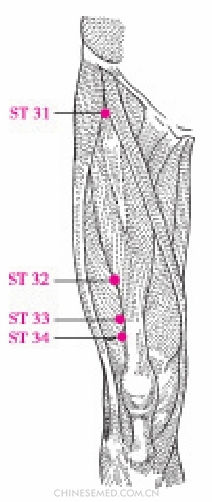
Location method. With the patient supine, the point is at the junction of a vertical line from the anterior superior iliac spine to the lateral border of the patella and a horizontal line level with the transverse gluteal crease. For easy location, place the midpoint of the first transverse wrist crease on ST 32 (fú tù) and stretch the hand horizontally forward; the point is at the tip of the middle fnger.
Actions. Strengthen the lumbar and knee, and unblock channels and collaterals.
Indications. Weakness, numbness and pain of the lower limbs, pain of the lower back and knees, numbness of foot, inability to fex and extend due to contraction of tendons.
Manipulation. Acupuncture: 1. Needle perpendicularly 1.5~ 2.5 cun to treat lateral femoral cutaneous neuritis. Local soreness can spread to the lateral thigh. 2. For hip pain, needle obliquely 2.0~3.0 cun with the needle tip upward, inducing needling sensation that spreads to the entire hip. 3. For lower limb disorders, angle the needle tip toward the medial aspect, inducing soreness at the anterior thigh; the sensation should spread toward the knee joint. 4. For widespread swelling and bruising due to local soft tissue injuries, use straight and side needling, triple needling, central-square needling, or the piercing method. Moxibustion: Use 5~10 cones of cone moxibustion, or use warming needle moxibustion for 20 minutes, or use a moxa stick for 10~20 minutes.
Annotation. The point is recorded in The Systematic Classicof Acupuncture and Moxibustion (Zhēn Jiŭ Jiă Yĭ Jīng, 针灸甲乙经). Bì refers to the femur, guān to the upper joint of the femur. This point is inferior to the anterior superior iliac spine close to the joint of the femur, so it is called bì guān.

ST 32 (Fú Tù, 伏兔)
Location At the anterolateral aspect of the thigh on the line connecting the lateral end of the base of the patella with the anterior superior iliac spine, 6 cun superior to the base of the patella (Pic. 3-21a, b).
Location method. Place the midpoint of the first transverse wrist crease on the midpoint of the superior border of the patella. Join the fngers together and place them on the large tendon; the point is where the tip of the middle fnger lies. Or with the patient supine, have him/her fex the toes with the legs straightened; the rectus femoris muscle bulges like a crouching rabbit at the anterior aspect of the thigh, superior to the knee. The point is at the midpoint of the muscle.
Actions. Disperse cold, resolve dampness, and dredge channels and collaterals.
Indications. Weakness, numbness, and pain of the lower limb, pain in lower back and knee, numbness of foot, inability to fex and extend due to contraction of tendons; hernia; barbiers.
Manipulation. Acupuncture: 1. Needle perpendicularly 1.5~2.5 cun; local soreness can spread to the knee. 2. For surrounding soft tissue injuries involving a larger area, straight and side needling, triple needling, central-square needling, or the piercing method may be used. Moxibustion: Use 5~10 cones of cone moxibustion, or use warming needle moxibustion for 20 minutes, or use a moxa stick for 10~20 minutes.
Annotation. The point is recorded in The Spiritual Pivot-Channels (Líng Shū-Jīng Mài, 灵枢·经脉). Fú means crouching; tù means rabbit. This point is located on the muscle belly of the rectus femoris muscle. The bulging muscle looks like a crouching rabbit, thus the point is named fú tù.
ST 33 (Yīn Shì, 阴市)
Location On the anterolateral aspect of the thigh lateral to the rectus femoris tendon, 3 cun superior to the base of the patella (Pic. 3-21a, b).
Location method. The point is located at the midpoint on the line connecting ST 32 (fú tù) with the lateral border of the base of the patella.
Actions. Disperse cold, resolve dampness, regulate qi, and relieve pain.
Indications. Atrophy and paralysis of the legs, inability to fex and extend the knee joint; hernia.
Manipulation. Acupuncture: Needle perpendicularly 1.5~2.5 cun; local soreness can spread to the knee. Moxibustion: Use 5~10 cones of cone moxibustion, or use warming needle moxibustion for 20 minutes, or use a moxa stick for 10~20 minutes.
Annotation. The point is recorded in The Systematic Classic of Acupuncture and Moxibustion (Zhēn Jiŭ Jiă Yĭ Jīng, 针灸甲乙经). Shì means market, a place of gathering. The qi that gathers here treats cold disorders of the waist, knee, and foot and warms the channels to dissipate cold.
ST 34 (Liáng Qiū, 梁丘)
Xi-cleft point
Location On the anterolateral aspect of the thigh 2 cun superior to the base of the patella between the vastus lateralis muscle and the lateral border of the rectus femoris tendon (Pic. 3-21a, b).
Location method. Ask the patient to tense the thigh muscles to reveal the vastus lateralis and rectus femoris muscles. The point is located 1 cun vertically below ST 33 (yīn shì) between these.
Actions. Regulate qi, harmonize the stomach, unblock channels, and quicken collaterals.
Indications. Stomachache, borborygmus, diarrhea; swelling and pain in the knee, atrophy and paralysis of the legs; mastitis.
Manipulation. Acupuncture: Needle perpendicularly 1.0~1.5 cun; local soreness can spread to the knee. Moxibustion: Use 7~9 cones of cone moxibustion, or use warming needle moxibustion for 20 minutes, or use a moxa stick for 10~20 minutes.
Precautions. The soft tissues below the point are thin and largely comprised of tendons. Insert to a depth of 1 cun to reach the lateral-inferior aspect of the femur; it is not advisable to insert deeper.
Annotation. The point is recorded in The Systematic Classic of Acupuncture and Moxibustion (Zhēn Jiŭ Jiă Yĭ Jīng, 针灸甲乙经). Liáng means roof beam; qiū means mound. The anterior of the femur is sturdy and huge like a roof beam, and the bulging muscle is like a mound, giving the point its name.
Modern clinical observation and research. In a case series (n=32) on acute stomach pain, ST 34 (liáng qiū) and ST 36 (zúsān lĭ) were needled bilaterally. At ST 34, the needling sensation spread to the hip and abdomen; at ST 36, it spread to the foot. Needles were retained for 30 minutes. After 1~3 treatments, 25 recovered; 7 improved significantly; of these, 5 recovered; 2 recurred.1
ST 35 (Dú Bí, 犊鼻)
Location On the anterior aspect of the knee in the depression lateral to the patellar ligament (Pic. 3-22a, b).
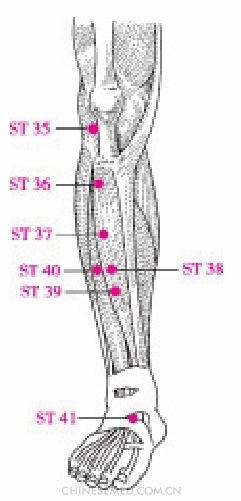
Actions. Unblock channels, quicken collaterals, reduce swelling, and relieve pain.
Indications. Pain in the knees, difficulty in flexing and extending the knees, paralysis of the legs, other disorders of the knee.
1 Hou J. Treating acute stomach pain with ST 34 (liáng qiū) and ST 36 (zú sān lĭ) 针刺梁丘、足三里治疗急性胃脘痛32 例. Journal of Emergency in Traditional Chinese Medicine. 2009; 18(2): 292-3.
Manipulation. Acupuncture: Needle obliquely and medially 1.0~1.5 cun from the anterior to the posterior of the knee; twirl. There will be local soreness, distention, and heaviness. Moxibustion: Use 5~9 cones of cone moxibustion, or use warming needle moxibustion for 20 minutes, or use a moxa stick for 10~20 minutes.
Annotation. The point is recorded in The Spiritual Pivot-Fundamental Points (Líng Shū-Běn Shū, 灵枢·本输). Dú means calf; bí means nose. This point is in the depression lateral to the patellar ligament, which is shaped like the nose of a calf; thus it was named dú bí.
ST 36 (Zú Sān Lǐ, 足三里)
He-sea and lower he-sea points of the stomach
Location At the anterior aspect of the leg 3 cun inferior to ST 35 (dú bí) on the line connecting ST 35 (dú bí) to ST 41 (jiĕ xī) (Pic. 3-22a, b).
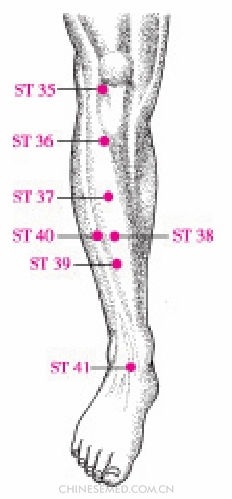
Location method. 1. With the patient’s knee bent, use one hand to fnd the anterior tibial crest; the point is 1 cun inferior and lateral to the crest. 2. With the knee bent, the point is 3 cun below ST 35 (dú bí), one fnger-breadth lateral to the anterior tibial crest (Pic. 3-23).
Actions. Invigorate the spleen, harmonize the stomach, reinforce healthy and original qi, unblock channels, activate collaterals, and regulate the movement of qi.
Indications. Stomachache, vomiting, abdominal pain and distention, diarrhea, dysentery, constipation, borborygmus; vexation, palpitation, shortness of breath, insomnia, psychosis, epilepsy; asthma, cough with abundance of phlegm, cough with blood; difficult urination, enuresis, hernia; acute mastitis, postpartum fainting due to hemorrhage, eclampsia, pernicious vomiting, leukorrhea; dysmenorrhea, bradytocia, hysteria; atrophy and paralysis of the legs, sore knee and tibia, barbiers; consumptive disease (deficiency due to overstrain).
Manipulation. Acupuncture: 1. Needle perpendicularly 0.5~1.5 cun; the needling sensation can travel along the foot yangming stomach channel to the ankle, dorsum of the foot, and toes. 2. Needle obliquely, needle tip slightly upward. Twirl to send the sensation along the channel to reach ST 31 (bì guān), ST 29 (guī lái), ST 25 (tiān shū), the stomach, or the xiphoid. 3. Use the dragon-tiger fighting method (lónghŭ jiāo zhàn fă, 龙虎交战法) to regulate qi and relieve pain. 4. Use the stem-branch grinding-mortar method (zĭ wŭ dăo jiù fă, 子午捣臼法) to alleviate edema by inducing diuresis. Moxibustion: Use 5~10 cones of cone moxibustion, or use warming needle moxibustion for 20 minutes, or use a moxa stick for 10~20 minutes. Once a year, scar with 100 moxa cones or use medicinal moxibustion to strengthen the body and preserve health.
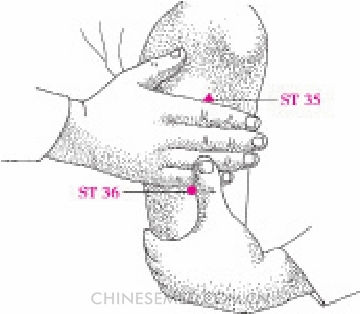
Precautions. To avoid piercing the posterior tibial nerve, vein, and artery, which can occur at a depth of more than 2 cun with the needle tip angled toward the tibia, do not needle too deeply.
Annotation. The point was recorded in The Spiritual Pivot-Five Pathogens (Líng Shū-Wǔ Xié,灵枢·五邪). Sān means three; lǐ is a unit equal to 1 cun; the point is 3 cun below the knee.
Modern clinical observation and research. In an RCT on functional dyspepsia (n=712), itopride or acupuncture at A. ST 42, ST 40, ST 36, and ST 34; B. non-specific stomach channel points; C. specific alarm and transport points; D. specific gallbladder channel points; E. sham acupuncture was given five times a week for four weeks. Dyspepsia improved in all groups and was sustained at follow up. Response rate was significantly highest in group A (70.69%) and lowest in group E (34.75%). The researchers concluded that point-specific acupuncture is effective for dyspepsia.1
ST 37 (Shàng Jù Xū, 上巨虚)
Lower he-sea point of the large intestine
Location At the anterior aspect of the leg 6 cun inferior to ST 35 on the line connecting ST 35 (dúbí) to ST 41 (jiĕ xī).
Location method. The point is located two four-finger measurements below ST 35 and one fnger-breadth lateral to the anterior crest of the tibia (Pic. 3-22a, b).
Actions. Harmonize the stomach and intestines, unblock channels, and activate collaterals.
Indications. Abdominal pain, diarrhea, dysentery, constipation, intestinal abscess, indigestion, cutting pain in intestines; atrophy and paralysis of the legs, sore knees and tibia.
Manipulation. Acupunture: 1. Needle perpendicularly 1.0~2.0 cun. There will be local soreness. The needling sensation can travel upward or downward. 2. Needle obliquely with the tip angled slightly upward to make the needling sensation ascend. 3. Needle obliquely with the tip slightly downward to make the sensation descend to the foot. 4. Use the dragon-tiger fighting method to regulate qi and relieve pain; use the stem-branch grinding-mortar method to alleviate edema by inducing diuresis. Moxibustion: Use 5~9 cones of cone moxibustion, or use warming needle moxibustion for 20 minutes, use a moxa stick for 10~20 minutes, or use medicinal moxibustion.
Precautions. Avoid puncturing the anterior tibial artery and vein when needling deeply.
Annotation. The point is recorded in Supplement to ‘Important Formulas Worth a ThousandGold Pieces’ (Qiān Jīn Yì Fāng, 千金翼方). Jù xū means huge depression or gap. This point got its name from its location superior to ST 39 (xià jù xū) in the large depression between the tibia and fbula.
Modern clinical observation and research. In a case series (n=30) on chronic diarrhea, ST 37 (shàng jù xū) was needled and warming needle moxibustion with 2 cm long moxa was applied; needles were retained for 30 minutes. Treatment was given once a day; fve treatments constituted a course, with three days between courses. After two courses, 19 recovered (63.3%) and 10 improved (33.4%); 1 case was unsuccessful (3.3%).2
ST 38 (Tiáo Kǒu, 条口)
Location At the anterior aspect of the leg 8 cun inferior to ST 35 (dú bí) on the line connecting ST 35 (dú bí) to ST 41 (jiĕ xī) (Pic. 3-22a, b).
1 Ma TT, Yu SY, Li Y, Liang FR, Tian XP, et al. Randomised clinical trial: An assessment of acupuncture on specific meridians or specific acupoints vs. sham acupuncture for treating functional dyspepsia. Aliment Pharmacol Ther. 2012; 35(5): 552-61.
2 Song GH, Sun QH. Thirty cases of chronic diarrhea treated by ST 37 (shàng jù xū) and warming needle moxibustion温针灸上巨虚穴治疗慢性腹泻30例. Chinese Journal of Traditional Medical Science and Technology. 2010; 17(1): 11.
Location method. The point is below ST 36 (zú sān lĭ) at the midpoint on a line connecting ST 35 to ST 41 and level with ST 40 (fēng lóng) on the tibialis anterior muscle.
Actions. Relax sinews, activate collaterals, regulate qi, and harmonize the center.
Indications. Pain in the abdomen and stomach, diarrhea, dysentery, constipation, intestinal abscess, hernia, borborygmus; cold pain in the lower leg, paralysis, barbiers, foot flaccidity, cold foot, swelling of the dorsum of foot and spasms; pain in shoulders and arms.
Manipulation. Acupuncture: Needle perpendicularly 1.0~3.0 cun; deep insertion can reach BL 57 (chéng shān). Local soreness and heaviness can spread to the lower leg and dorsum of the foot. Moxibustion: Use 3~5 cones of cone moxibustion, or use warming needle moxibustion for 20 minutes, or use a moxa stick for 5~20 minutes.
Precautions. See ST 37 (shàng jù xū).
Annotation. The point was recorded in The Systematic Classic of Acupuncture and Moxibustion (Zhēn Jiŭ Jiă Yĭ Jīng, 针灸甲乙经). Tiáo means lines; kŏu means an opening. This point is in the depression between muscles that look like lines, so it is called tiáo kŏu.
Modern clinical observation and research. In an observation on various needling methods at ST 38 (tiáo kŏu) in periarthritis of the shoulder, insertion toward BL 57 (chéng shān) plus passive, gentle movement of the shoulder joint to increase the range of motion and subsequent acupuncture at LI 15 (jiān yú), SJ 14 (jiān liáo) and SI 9 (jiān zhēn), was found to be the best. Treatment was once a day, fve times a week, ten in total. Effects were significantly best with this method.1
ST 39 (Xià Jù Xū, 下巨虚)
Lower he-sea point of the small intestine
Location At the anterior aspect of the leg 9 cun below ST 35 (dú bí) on the line connecting ST 35 (dú bí) to ST 41 (jiĕ xī) (Pic. 3-22a, b).
Location method. The point is two four-fnger measurements directly below ST 36 (zú sān lĭ) when the patient is sitting upright with the knee bent.
Actions. Regulate the intestines and stomach, unblock channels, and calm the mind.
Indications. Lower abdominal pain, borborygmus, diarrhea, dysentery; atrophy and paralysis of the lower leg, barbiers, cold foot, swelling of the dorsum of foot, spasms.
Manipulation. Acupuncture: Needle perpendicularly 1.0~2.0 cun. Local soreness can spread to the dorsum of the foot. Moxibustion: Use 5~9 cones of cone moxibustion, or use warming needle moxibustion for 20 minutes, or use a moxa stick for 10~20 minutes.
Precautions. See ST 37 (shàng jù xū).
Annotation. The point was recorded in Important Formulas Worth a Thousand Gold Pieces (Qiān Jīn Yào Fāng, 千金要方). Jù xū means huge depression. Shàng and xià mean up and down respectively and are relative to each other. This point is below ST 37 (shàng jù xū) in the depression between tibia and fbula and thus is called xià jù xū.
ST 40 (Fēng Lóng, 丰隆)
Luo-connecting point
Location On the anterolateral aspect of the leg 8 cun superior to the prominence of the lateral malleolus at the lateral border of the tibialis anterior muscle (Pic. 3-22a, b).
1 Zhao H, Zhao T, Liu BY, Liu ZS. Observation of the differences in effects in treating scapulohumeral periarthritis by needling ST 38 (tiáo kŏu) using different methods条口穴不同刺法对肩周炎疗效差异的观察. Chinese Acupuncture & Moxibustion. 2006; 26(10): 729-31.
Location method. The point is one finger-breadth lateral to ST 38 (tiáo kŏu) on the line connecting ST 35 (dú bí) and the prominence of the lateral malleolus.
Actions. Fortify the spleen, dissolve phlegm, harmonize the stomach, direct counterflowing qi downward, and resuscitate.
Indications. Abdominal distention, constipation; psychosis, excessive laughter, epilepsy, somnolence, hysteria, and plum-stone qi (globus hystericus); cough with abundance of phlegm; soreness, atrophy and paralysis of the legs.
Manipulation. Acupuncture: 1. Needle perpendicularly 1.0~1.5 cun to treat atrophy and paralysis of the legs and swelling of the foot. The needling sensation can travel along the foot yangming channel to the ankle or even to the second and third toes on the dorsum of the foot. 2. Needle obliquely with the needle tip slightly toward the knee to treat disorders of the upper and middle jiao. The needling sensation can travel along the stomach channel to ST 31 (bì guān), ST 25 (tiān shū), and even the stomach, supraclavicular fossa, and head. Moxibustion: Use 5~7 cones of cone moxibustion, or use warming needle moxibustion for 20 minutes, or use a moxa stick for 10~20 minutes.
Precautions. Deep insertion is not advisable.
Annotation. The point was recorded in The Spiritual Pivot-Channels (Líng Shū-Jīng Mài, 灵枢·经脉). Fēn⁝ means abundant; lóng means bulging. This point is between the lateral border of the extensor digitorum longus and the peroneus brevis where the muscles are abundant and bulging; thus it is named fēng lóng.
Modern clinical observation and research. In a case study on primary hyperlipidemia belonging to the phlegm-turbid pattern, dense-disperse EA was administered at ST 40 (fēng lóng) and SP 9 (yīnlíng quán) 30 minutes a day, 5 times a week for 6 weeks. A total of 12 recovered, 11 significantly improved, and 6 improved; 5 cases were unsuccessful.1
ST 41 (Jiě Xī, 解溪)
Jing-river point
Location On the anterior aspect of the ankle in the depression between the extensor hallucis longus and extensor digitorum longus tendons (Pic. 3-22a, b).
Location method. With the patient’s toes lifted to Define the two tendons on the dorsum of the foot, the point is between them at the midpoint of a line connecting the prominences of the lateral and medial malleolus.
Actions. Relax sinews, quicken collaterals, clear the stomach, dissolve phlegm, suppress fright, and calm the mind.
Indications. Headache, vertigo; abdominal distention, constipation; psychosis; atrophy and paralysis of the legs, drooping of foot, disorders of ankle and soft tissues.
Manipulation. Acupuncture: 1. Needle perpendicularly 0.3~0.5 cun. 2. Needle transversely 1.0~1.5 cun toward GB 40 (qiū xū) or SP 5 (shāng qiū). Local soreness and distention can spread to the entire ankle. Moxibustion: Use 3~5 cones of cone moxibustion, or use a moxa stick for 5~10 minutes.
Precautions. Resistance after inserting the needle means that the ankle joint capsule has been pierced; do not insert further. 2. Scarring moxibustion is not suitable.
1 Hu YP, Lu S, Xu LB, Wang YJ. Research on the clinical effects of ST 40 (fēng lóng) and SP 9 (yīn líng quán) with electroacupuncture to treat primary hyperlipidemia belonging to the phlegm-turbid pattern电针丰隆、阴陵泉治疗原发性高脂血症临床疗效研究. Journal of Clinical Acupuncture and Moxibustion. 2008; 24(3): 6-7.
Annotation. The point was recorded in The Spiritual Pivot-Fundamental Points (Líng Shū-Běn Shū, 灵枢·本输). It is where the shoelaces are tied at the ankle in the depression between two tendons that is like a valley between two streams; hence the name jiě xī.
ST 42 (Chōng Yáng, 冲阳)
Yuan-source point
Location On the dorsum of the foot over the dorsalis pedis artery at the joint of the base of the second metatarsal and the intermediate cuneiform (Pic. 3-24).
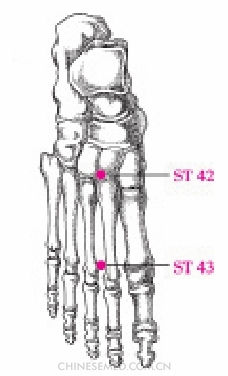
Actions. Harmonize the stomach, dissolve phlegm, unblock collaterals, and calm the mind.
Indications. Heaviness of the head, headache, deviation of the mouth and eyes, toothache, swollen check; vomiting, abdominal distention, pain in stomach, poor appetite; susceptibility to fright, psychosis, epilepsy; weakness and numbness of the the foot, inability to contract foot, red and swollen dorsum of the foot.
Manipulation. Acupunture: Needle perpendicularly 0.2~0.3 cun; avoid the artery. Moxibustion: Use 3~5 cones of cone moxibustion, or use a moxa stick for 5~10 minutes.
Precautions. Avoid the artery. Scarring moxibustion is not suitable.
Annotation. The point was recorded in The Spiritual Pivot-Fundamental Points (Líng Shū-BěnShū, 灵枢·本输). Chōng refers to the throbbing of an artery; yáng, to the dorsum of the foot. The point is on the elevated area of the dorsum where the pulsating artery may be palpated; hence the name chōng yáng.
ST 43 (Xiàn Gǔ, 陷谷)
Shu-stream point
Location On the dorsum of the foot between the second and third metatarsal bones in the depression proximal to the second metatarsophalangeal joint (Pic. 3-24).
Actions. Clear heat, release the exterior, harmonize the stomach, promote diuresis, regulate qi, and relieve pain.
Indications. Borborygmus, abdominal pain; facial and general edema; swelling and pain in the dorsum of the foot.
Manipulation. Acupuncture: 1. Needle perpendicularly 0.3~0.5 cun. 2. Needle obliquely upward 0.5~1.0 cun. Local soreness can spread to the entire dorsum of the foot. Moxibustion: Use 3~5 cones of cone moxibustion, or use a moxa stick for 5~10 minutes.
Precautions. Scarring moxibustion is not suitable.
Annotation. The point is recorded in The Spiritual Pivot-FundamentalPoints (Líng Shū-Běn Shū, 灵枢·本输). It is in the depression anterior to the juncture of the second and third metatarsal bones. The depression is like a valley, so the point is called xiàn gǔ.
ST 44 (Nèi Tíng, 内庭)
Ying-spring point
Location On the the dorsum of the foot between the second and third toes, posterior to the web and at the border between the red and white fesh (Pic. 3-25).
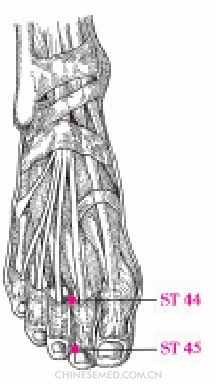
Actions. Clear the stomach, drain fre, regulate qi, and relieve pain.
Indications. Abdominal pain, abdominal distention, diarrhea, dysentery; toothache, facial pain, headache, deviated mouth, pharyngitis, nosebleed; febrile diseases; swelling and pain in the dorsum of the foot, pain in the metatarsophalangeal joint.
Manipulation. Acupuncture: 1. Needle perpendicularly or obliquely 0.3~0.5 cun. There will be local soreness. 2. Needle obliquely upward and manipulate the needle after obtaining qi; the needling sensation can ascend along the channel. Moxibustion: Use 3~5 cones of cone moxibustion, or use a moxa stick for 5~10 minutes.
Precautions. Scarring moxibustion is prohibited.
Annotation. The point is recorded in The Spiritual Pivot-Fundamental Points (Líng Shū-Běn Shū, 灵枢·本输). Nèi means inner; tíng means courtyard. This point is on the margin of the web between the second and third toes on the dorsum of the foot. The toe crease is like a gate and resembles the entrance to an inner courtyard; thus the point was named nèi tíng.
ST 45 (Lì Duì, 厉兑)
Jing-well point
Location On the second toe lateral to the distal phalanx, 0.1 cun proximal-lateral to the lateral corner of the toenail at the intersection of a vertical line along the lateral border and a horizontal line along the base of the nail (Pic. 3-25).
Actions. Clear heat, harmonize the stomach, induce resuscitation, unblock channels, and quicken collaterals.
Indications. Nosebleed, toothache, swollen and sore throat; nightmare, psychosis; abdominal distention, borborygmus, abdominal pain; febrile diseases; foot pain.
Manipulation. Acupuncture: 1. Needle superficially 0.1~0.2 cun. There will be local distending pain. 2. Bleed with a three-edged needle. Moxibustion: Use 1~3 cones of wheat-grain sized moxibustion, or use a moxa stick for 5~10 minutes.

